
THE DOG THAT DIDN’T BARK:
LOOKING FOR TECHNO-LIBERTARIAN IDEOLOGY
IN A DECADE OF PUBLIC DISCOURSE ABOUT BIG
TECH REGULATION
JODI L. SHORT, REUEL SCHILLER, SUSAN S. SILBEY, NOAH
JONES, BABAK HEMMATIAN, AND LEEANNA BOWMAN-
CARPIO
1
The internet was built on the techno-libertarian ideology that “information
wants to be free,” and that ideology has played a prominent role in academic
and policy debates about regulating the internet and the big technology
companies that dominate it.
2
Techno-libertarian ideology has generated a
constellation of claims about tech and regulation—from the suggestion that
regulation will stifle innovation in the complex, dynamic tech sector, to the
assertion that the large platform companies are literally not regulable. In
this article, we explore how much traction such claims and ideologies have in
the broader public discourse about big tech and regulation. We employ an
innovative methodology—topic modeling—to track public discourse on the
regulation of big technology from 2010 to 2020. We find that techno-
libertarian ideas about free markets and information freedom play a
surprisingly small role in this discourse. Indeed, we find that the most
common themes in the discourse about big tech and regulation concern: calls
1
Jodi Short is the Associate Dean for Research and the Honorable Roger J. Traynor
Professor of Law at UC Hastings College of the Law. Reuel Schiller is the Honorable Roger
J. Traynor Chair and Professor of Law at the University of California, Hastings College of
Law. Susan S. Silbey is the Leon and Anne Goldberg Professor of Humanities, Sociology
and Anthropology at the Massachusetts Institute of Technology and a Professor of
Behavioral and Policy Sciences at the Sloan School of Management at MIT. Noah Jones is a
2022 graduate of Brown University. Babak Hemmatian is a Beckman Postdoctoral
Research Fellow at the University of Illinois, Urbana-Champaign. LeeAnna Bowman-
Carpio is a 2022 graduate of the University of California, Hastings College of the Law.
2
R. Polk Wagner, Information Wants to Be Free: Intellectual Property and the
Mythologies of Control, 103 COLUM. L. REV. 995, 1033 (2003).
The Ohio State Technology Law Journal
2
THE OHIO STATE TECHNOLOGY LAW JOURNAL
[Vol. 19.1
to regulate big tech companies; growing critiques of technology’s influence
in society; and declining discussion of the tech sector as a driver of economic
growth. Our findings should embolden legal and policy advocates to pursue
regulatory initiatives aimed at addressing the social and economic harms
produced by the technology sector knowing that the techno-libertarian
rhetoric likely to be deployed against them may not have sufficient public
traction to win the day.
2022]
SHORT
3
TABLE OF CONTENTS
I. INTRODUCTION ..................................................................... 4
II. THE TECHNO-LIBERTARIAN IDEOLOGY .......................... 6
III. TOPIC MODELING ............................................................. 19
A. WHAT IS TOPIC MODELING? ........................................ 19
B. METHODOLOGY ............................................................... 22
C. THE LIMITATIONS OF ALGORITHMIC TOPIC
MODELING ............................................................................ 28
IV. PUBLIC DISCOURSE ON BIG TECH REGULATION:
FINDINGS .................................................................................. 29
V. CONCLUSION ....................................................................... 42
APPENDIX 1: CHOICE OF HYPERPARAMETERS .................. 43
APPENDIX 2: CALCULATING TOPIC CONTRIBUTIONS ...... 44

4
THE OHIO STATE TECHNOLOGY LAW JOURNAL
[Vol. 19.1
I. Introduction
The last fifty years have seen technological innovations that
have dramatically transformed our society. The microcomputer, the
internet, and wireless technology, for example, have changed the way
we consume and communicate in ways that few could have imagined in
1970. Yet the creators of this technology did not simply develop
hardware and software. They also fashioned a system of beliefs. They
have propagated a libertarian ideology that has played a prominent role
in academic and policy debates about regulating the internet and the
big technology companies that dominate it.
Indeed, no industry has been more zealous in crafting and
championing a regulatory ideology than the tech sector. Characterized
variously as technological utopianism, techno-utopianism, or techno-
libertarianism (the moniker we adopt here), this ideology envisions
cyberspace as a domain of “perfect freedom”
3
—a space that promises “a
kind of society that real space would never allow—freedom without
anarchy, control without government, consensus without power.”
4
Techno-libertarianism has generated a constellation of claims about
tech and regulation—that government regulation will stifle innovation
in the dynamic tech sector, that it is unnecessary because market forces
and the tech companies’ own benevolence will prevent social harms,
and that, where regulation is called for, self-regulation is the only
effective way to order the behavior of companies in this complex
industry.
5
Ideologies about regulation shape how—and even whether—
the state regulates.
6
Thus, both advocates and opponents of increased
regulation of the technology sector should want to understand the
ideological and rhetorical landscape upon which these political battles
are occurring. Exactly how much traction do techno-libertarian claims
and ideologies have in the broader public discourse?
To find out, we employ a methodology innovative in legal
scholarship to track public discourse on the regulation of large
3
LAWRENCE LESSIG, CODE: VERSION 2.0, at 3 (2006).
4
Id. at 2.
5
David R. Johnson & David Post, Law and Borders—The Rise of Law in Cyberspace, 48
STAN. L. REV. 1367, 1375 (1996) (“The rise of an electronic medium that disregards
geographical boundaries throws the law into disarray by creating entirely new phenomena
that need to become the subject of clear legal rules but that cannot be governed,
satisfactorily, by any current territorially based sovereign.”); LESSIG, supra note 3, at 31
(statement of Tom Steinert-Threlkeld) (“Some things never change about governing the
Web. Most prominent is its innate ability to resist governance in any form.”); id. (“If there
was a meme that ruled talk about cyberspace, it was that cyberspace was a place that could
not be regulated.”).
6
See Jodi L. Short, The Paranoid Style in Regulatory Reform, 63 HASTINGS L.J. 633
(2012).

2022]
SHORT
5
technology corporations from 2010 to 2020. We use a topic modeling
algorithm to systematically search for discursive trends in a large
corpus of news articles. As we describe in more detail in Part II, topic
modeling is a computational technique that allows for the systematic
study of cultural representations. It is a digitized method for analyzing
textual data to identify common themes and relationships in large
bodies of text, thereby uncovering explicit and latent motifs.
7
Unlike
word-based methods for quantitative content analysis,
8
topic modeling
does not simply count frequencies. Instead, using both the frequency of
particular words and their co-occurrence with respect to one another,
the topic model accounts for the probability that certain words occur
together and for the weight each word contributes to these probability
distributions. The most highly weighted words provide clues about the
significance of particular subjects, or “topics,” which can then be
explored with more conventional interpretative techniques. Because
topic modeling techniques work on large bodies of text,
9
this paper
illustrates how they can prove particularly useful for legal and policy
analysis.
Using topic modeling, we find that techno-libertarian (or even
just plain old libertarian) ideas about free markets and information
freedom play a surprisingly small role in the public discourse, despite
the technology corporations’ relentless emphasis on them. Indeed, we
find that the most common themes in the discourse about big tech and
regulation concern the need to regulate big tech companies. As policy
makers embark on discussions about whether and how to regulate this
powerful sector, they should be aware of these broader trends. The
utopian narratives that big tech companies (and their lobbyists) tell
about themselves do not seem to have captured the public’s
imagination. This fact leaves policymakers with more room to operate
as they craft regulatory responses to the social costs that have
accompanied technological innovation.
The Article proceeds as follows. Part I presents a qualitative
description of the techno-libertarian ideology using source material
produced by or documenting the views of tech companies, their
executives, and their lobbyists. It explores how the ideology developed
and discusses how it shaped the architecture and ethos of internet, as
well as the ideas about how computer technologies should be regulated.
It also documents how techno-libertarian ideas have been deployed in
recent legal and policy debates about the regulation of technology
7
Tim Hannigan et al., Topic Modeling in Management Research: Rendering New Theory
From Textual Data, 13 ACAD. MGMT. ANNALS 589 (2019).
8
See Yla R. Tausczik & James W. Pennebaker, The psychological meaning of words:
LIWC and computerized text analysis methods, 29 J. LANGUAGE & SOC. PSYCH. 24-54.
9
Hannigan et al., supra note 7, at 589.

6
THE OHIO STATE TECHNOLOGY LAW JOURNAL
[Vol. 19.1
companies, including state privacy legislation, municipal regulation of
ride sharing platforms, and proposed Congressional legislation to
ensure the accuracy of ads placed on social media. In doing so, it
highlights how big tech companies have mobilized elements of techno-
libertarian discourse to resist attempts to regulate them. This
qualitative account motivates the empirical question we seek to address
with our topic model: how much do techno-libertarian claims and
ideologies contribute to the broader public discourse relating to the
regulation of major technology companies?
Part II explains what topic modeling is in some detail. It then
describes our empirical study of the public discourse about regulating
large technology corporations and explains our methodology. Part III
presents the results of our study. We find that techno-libertarian
ideologies do not dominate public discourse on the regulation of big
tech. Instead, this discourse is dominated by calls to regulate big tech,
growing critiques of technology’s influence in society, and declining
discussion of the tech sector as a driver of economic growth. This article
then concludes, arguing that the nature of this discourse suggests that
policymakers should not assume that the public accepts the anti-
regulatory premises of techno-libertarianism. Consequently, these
policymakers should realize that they are operating in a more pro-
regulatory political environment than they might have otherwise
believed.
II. The Techno-Libertarian Ideology
The morning of March 3, 1998, was an unusual one for Bill
Gates, then 42-year-old chairman of the Microsoft Corporation. Gates
was in Washington, D.C., testifying before the Senate Judiciary
Committee.
10
Capitol Hill was not a place where Gates felt comfortable.
Unlike many of his colleagues and competitors in the technology sector,
Gates had always sought to avoid political entanglements.
11
Indeed, the
previous year, the company had donated less than $100,000 to federal
political candidates.
12
Its lobbying operation consisted of a single
10
Rajiv Ch & Rasekaran, Microsoft in Senates Focus, WASH. POST (March 3, 1998),
https://www.washingtonpost.com/archive/business/1998/03/03/microsoft-in-senates-
focus/2a403de5-8088-470b-8485-a40f7229cf3e/ [https://perma.cc/5JKX-3ZZK].
11
Stephanie Simon & Erin Mershon, Gates masters D.C. – and the world, POLITCO
(February 04, 2014, 8:01 PM), https://www.politico.com/story/2014/02/bill-gates-
microsoft-policy-washington-103136 [https://perma.cc/L86V-3P7F].
12
Joel Brinkley, U.S. v. Microsoft: The Lobbying, N.Y. TIMES, Sept. 7, 2001,
https://www.nytimes.com/2001/09/07/business/us-vs-microsoft-the-lobbying-a-huge-4-
year-crusade-gets-credit-for-a-coup.html [https://perma.cc/F9GV-4F4U].

2022]
SHORT
7
person operating out of an office in a Chevy Chase shopping mall.
13
Gates seemed to believe that if he ignored Washington, it would ignore
him.
Gates’ appearance on Capitol Hill was not the only unusual
thing about the hearing. Even stranger was how poorly he was received.
Used to kit-gloved treatment by a public that viewed him as the self-
made, boy genius fueling the PC revolution, he was not expecting the
bipartisan drubbing he would receive that day. After a day of defending
himself from accusations of being a greedy, disingenuous monopolist,
the New York Times described Gates as “shellshocked.”
14
What brought Gates to Washington that day was what have
become known as “The Browser Wars.”
15
By the middle of the 1990s,
the Internet had ceased to be merely a tool of academics and computer
aficionados.
16
Through search engines and social networking
platforms, a market for user-friendly software allowing people to access
the World Wide Web had quickly sprung up.
17
Initially, this market was
dominated by Netscape Communications, whose product, Netscape
Navigator, had gobbled up 80% of the browser market by 1996.
18
That
year, however, Microsoft introduced its own browser—Internet
Explorer—and bundled it with its industry-dominant operating system,
Windows 95.
19
As Internet Explorer quickly ate away at its market
share, Netscape brought an antitrust lawsuit against Microsoft,
claiming that it was using its near-monopoly in operating systems to
prevent competition in the market for browsers.
20
As the lawsuit
commenced, Congress invited Gates to the Capitol.
21
The facts alleged
in Netscape’s lawsuit, it seems, put some legislators in a regulatory
mindset.
13
MARGARET O’MARA, THE CODE: SILICON VALLEY AND THE REMAKING OF AMERICA 350
(2019); Brinkley, supra note 12.
14
Lizette Alvarez, An ‘Icon of Technology’ Encounters Some Rude Political Realities, N.Y.
TIMES (March 4, 1998), https://www.nytimes.com/1998/03/04/business/an-icon-of-
technology-encounters-some-rude-political-realities.html [https://perma.cc/3QRW-
2ZAF].
15
For the Browser Wars, see O’MARA, supra note 13, at 341–46.
16
Id. at 287.
17
Id. at 309.
18
Henry R. Norr, Netscape Communications Corp., ENCYC. BRITANNICA (August 28, 2017),
https://www.britannica.com/topic/Netscape-Communications-Corp
[https://perma.cc/TBB7-VBFK].
19
Paul Thurrott, Microsoft to release Windows 95 OSR 2.5, ITPRO TODAY (October 19,
1997), https://www.itprotoday.com/windows-78/microsoft-release-windows-95-osr-25
[https://perma.cc/L6RA-5VHE].
20
O’MARA, supra note 13, at 341–46.
21
Competition, Innovation, and Public Policy in the Digital Age: Hearings Before the S.
Comm. on the Judiciary, 105th Cong. 87 (1998) (statement of Bill Gates, Chairman and
CEO, Microsoft Corp.).

8
THE OHIO STATE TECHNOLOGY LAW JOURNAL
[Vol. 19.1
Gates’ testimony was designed to deflect such impulses. He
delivered a simple message: “The PC industry,” as he called it, was a
goose laying golden eggs.
22
By creating innovative hardware and
software, it generated high-paying jobs, and inexpensive, high-quality
products.
23
Furthermore, American economic growth relied on this
continued innovation, both to keep the technology sector expanding
and to maintain and accelerate other economic sectors that had become
increasingly dependent on technology to compete in a global
marketplace.
24
Government regulation, Gates claimed, would kill the
goose. “To remain competitive and to continue to provide consumers
with high quality, low cost, innovative products . . . software companies
must retain the ability to design their products free from government
interference.”
25
Such “government intervention” “hobbled” the
industry, preventing it from developing “new products that meet the
needs of consumers.”
26
According to Gates, politicians who attempted to regulate
technology industries failed to understand how the industry worked.
No matter how big an existing company was, its products could, at any
moment, be rendered obsolete by individual entrepreneurs— “college
room buddies” working out of “small offices,” “hobbyists” holed-up in
garages, or “innumerable other . . . small entrepreneurs” developing
software at their “kitchen table.”
27
Freedom from government
interference was the key to facilitating this sort of low-capital
competition and innovation. “The software industry’s success has not
been driven by Government regulation, but by freedom and the basic
human desire to learn to innovate and to excel.”
28
Gates was not without allies at the hearings. Tech sector
entrepreneurs Michael Dell and Douglas Burgum echoed his talking
points.
29
The technology industry “started quite literally in the garages,
kitchens, and dormitory rooms of this country. Part of the appeal of this
industry is the freedom to succeed or fail based solely on one’s own
abilities.”
30
Success was thus the product of individual initiative “free
from government regulation . . . .”
31
The venture capitalist/tech
journalist Stewart Alsop, II was even more explicit. “I believe that it is
22
Id. at 90.
23
Id. at 91.
24
Id.
25
Id. at 94.
26
Id. at 96.
27
Id. at 89, 92.
28
Id. at 89.
29
See id. at 113-126 (statements of Michael Dell, Chairman and CEO, Dell Computer Corp.
& Douglas J. Burgum, Chairman and CEO, Great Plains Software).
30
Id. at 125 (statement of Douglas J. Burgum, Chairman and CEO, Great Plains Software).
31
Id.

2022]
SHORT
9
dangerous and potentially disastrous to invite governmental regulation
of the interfaces between elements of the technology we are adopting at
such a remarkable rate.”
32
Dramatically, he likened the hearings to
Joseph McCarthy’s “destructive demagoguery.”
33
He then articulated a
radically antiregulatory stance based on his assessment of the state’s
inevitable regulatory incompetence:
I want to be clear that I also grew up in a time when the
Government proved itself incapable of judicious or expeditious
regulation of the economy as a whole or even of individual
industries, and I learned to distrust a centralized government's
ability to regulate itself or to act in the best interests of its
constituency over the long term.
34
According to Alsop, this hostility to regulation was particularly
appropriate when it came to the regulation of technology. This was
because the personal computer was unlike the earlier technologies—
railroads, petrochemicals, “large-scale manufacturing”—that had
generated previous regulatory impulses.
35
Businesses in those
industries required centralized, hierarchical power that might itself
become oppressive. The tech industry, on the other hand, had no such
potential. Not only did it spring from the initiative of decentralized,
individual entrepreneurs, but it also promoted individual freedom by
destroying hierarchies, both public and private.
The personal computer has challenged corporations’ ability to
control computing resources centrally, empowering
individuals, and breaking down hierarchies. Communications
technologies have made it nearly impossible for centralized
governments to control access to information. The Internet and
the World Wide Web have suddenly removed the structural
costs of gaining access to and managing information in a
fashion unprecedented in human experience.
36
In such a world, regulation was unnecessary. Not only would it stifle
economic growth and technological innovation. It would also
undermine the transformation of the society from a centralized one
based on large, potentially oppressive, institutions to one that was
32
Id. at 128 (statement of Stewart Alsop, II).
33
Id.
34
Id.
35
Id.
36
Id.

10
THE OHIO STATE TECHNOLOGY LAW JOURNAL
[Vol. 19.1
decentralized and egalitarian, driven by networked individuals each
liberated to create, innovate, and flourish.
By the time that Gates, Dell, Burgum, and Alsop appeared
before Congress in early 1998, the tech utopianism that their testimony
reflected was pervasive in American society. In the past three decades
a host of scholars and journalists—Richard Barbrook, Andy Cameron,
Fred Turner, Margaret O’Mara, Scott Galloway, John Markoff, Paulina
Borsook, Alan Lui, Vincent Mosco, Tiziana Terranova, for example—
have described the emergence of this ideology, and the politics that
accompanied it.
37
It took libertarian beliefs—that human society was
best structured by leaving individuals alone to pursue their self-
interests—and linked them to decentralized digital technologies to
explain precisely how this liberation would occur. Personal computers
acted as agents of freedom, promoting liberty and innovation by
creating a hybrid digital-actual society that was free of hierarchical
restraints, be they public or private. In this environment, decentralized
action would generate the best ideas, products, and forms of social
organization. It was a dynamic world of constant, decentralized
innovation in which monopoly was a meaningless concept. Every
corporate behemoth was nothing more than a Goliath waiting to be
toppled by the next David (or Steve, Mark, Jeff, or Elon) whose
unanticipated innovation would soon spring from a Cupertino garage.
Indeed, to the extent that new technologies created social problems,
they would solve these problems themselves. If the internet made
pornography easily available to seven-year-olds, then a filtering
program would solve the problem.
38
If social networks became
platforms for inflaming ethnic hatreds, then subtle algorithms were the
37
See generally Richard Barbrook & Andy Cameron, The Californian Ideology, 6 SCI. AS
CULTURE 44-72 (1996), http://www.imaginaryfutures.net/2007/04/17/the-californian-
ideology-2 [https://perma.cc/BCE9-VNFH]; FRED TURNER, FROM COUNTERCULTURE TO
CYBERCULTURE: STEWART BRAND, THE WHOLE EARTH NETWORK, AND THE RISE OF DIGITAL
UTOPIANISM (2006); O’MARA, supra note 13; SCOTT GALLOWAY, THE FOUR: THE HIDDEN
DNA OF AMAZON, APPLE, FACEBOOK, AND GOOGLE (2017); JOHN MARKOFF, WHAT THE
DOORMOUSE SAID: HOW THE SIXTIES COUNTERCULTURE SHAPED THE PERSONAL COMPUTER
INDUSTRY (2005); PAULINA BORSOOK, CYBERSELFISH: A CRITICAL ROMP THROUGH THE
TERRIBLY LIBERTARIAN CULTURE OF HIGH TECH (2000); ALAN LIU, THE LAWS OF COOL:
KNOWLEDGE WORK AND THE CULTURE OF INFORMATION (2004); VINCENT MOSCO, THE
DIGITAL SUBLIME: MYTH, POWER, AND CYBERSPACE (2004); TIZIANA TERRANOVA, NETWORK
CULTURE: POLITICS FOR THE INFORMATION AGE (2004).
38
See generally Marie Eneman, Internet Filtering: A Solution to Harmful and Illegal
Content?, IEEE SMARTWORLD, UBIQUITOUS INTELLIGENCE & COMPUTING, ADVANCED &
TRUSTED COMPUTING, SCALABLE COMPUTING & COMMUNICATIONS, CLOUD & BIG DATA
COMPUTER, INTERNET OF PEOPLE AND SMART CITY INNOVATION
(SMARTWORLD/SCALCOM/UIC/ATC/CBDCOM/IOP/SCI) 354-549 (2019),
https://doi.org/10.1109/SmartWorld-UIC-ATC-SCALCOM-IOP-SCI.2019.00104
[https://perma.cc/P2VN-AM66] (canvasing and evaluating the use of Internet filtering for
child abuse material).

2022]
SHORT
11
solution.
39
Worried about on-line privacy? Implement your privacy
settings just so.
The corollary to these beliefs was that decisions made by the
market—the “electronic agora”
40
—were preferable to those made by
the state. Technology had created a pure marketplace of ideas. Thus,
governance generated by the decentralized, technology-enabled
decision-making processes of a networked world would be better than
the decision of any government bureaucrat, no matter how well
intentioned. When Gates, Dell, Burgum, and Alsop made this argument
before Congress in 1998, they were simply articulating what had
become the common wisdom of the denizens of the tech sector for over
thirty years. It was a strange amalgam of ideas constructed out of
classical libertarianism, counterculture communalism, postwar
cybernetic theory, and science fiction inflected-utopianism, but its view
of the state and its role as a regulator was clear. As Esther Dyson,
George Gilder, George Keyworth, and Alvin Toffler wrote in their 1994
tech manifesto, “Magna Carta for the Knowledge Age”:
41
“Today we
have, in effect, universal access to personal computing—which no
political coalition ever subsidized or ‘planned.’” Consequently, “if there
is to be an ‘industrial policy for the knowledge age,’ it should focus on
removing barriers to competition and massively deregulating the fast-
growing telecommunications and computing industries.”
42
Indeed,
such deregulatory impulses should ultimately cast an even wider net.
“[A] ‘mass movement’ for cyberspace is still hard to see . . . Yet there
are key themes on which this constituency-to-come can agree. To start
with, liberation—from . . . rules, regulations, taxes, and laws laid in
place to serve the smokestack barons and bureaucrats of the past.”
43
Techno-libertarian ideology continued to dominate Silicon
Valley’s discourse about itself long after founding entrepreneurs moved
out of their dorm rooms and garages and onto Wall Street. By 2019, the
five largest technology corporations—Apple, Amazon, Facebook,
Google/Alphabet, and Microsoft—had achieved market domination,
their stock worth “more than the entire economy of the United
Kingdom.”
44
Yet the rhetoric remained the same, nurtured by
39
MONIKA BICKERT, FACEBOOK, CHARTING A WAY FORWARD: ONLINE CONTENT REGULATION
(2020).
40
Barbrook & Cameron, supra note 37.
41
TURNER, supra note 37, at 228-232 (Turner describes the writing of this document and
its diverse ideological and theoretical antecedents.).
42
Esther Dyson, George Gilder, George Keyworth & Alvin Toffler, Cyberspace and the
American Dream: A Magna Carta for the Knowledge Age, FUTURE INSIGHT (Aug. 1994)
http://www.pff.org/issues-pubs/futureinsights/fi1.2magnacarta.html
[https://perma.cc/Q3DW-7GGZ].
43
Id.
44
O’MARA, supra note 13, at 1.

12
THE OHIO STATE TECHNOLOGY LAW JOURNAL
[Vol. 19.1
iconoclastic founders and funders like Peter Thiel
45
and Elon Musk,
46
and employed strategically by tech companies to thwart attempts to
regulate them. Thus, faced with the prospect of regulation, big tech
companies repeated the same themes that Gates’ deployed in the
1990s: their industry produced enormous benefits for the public;
47
it
was able to produce these benefits because the government left it alone
to innovate;
48
government regulation would kill innovation and all the
public benefits attendant to it;
49
and whatever social problems novel
technologies created could be solved through self-regulation.
50
In recent years, the industry has had many opportunities to
deploy these arguments as calls for regulation of the technology sector
have gained momentum in response to growing recognition of the
harms the technology sector has caused and the future dangers it
threatens. Platform companies’ relentless surveillance and
expropriation of users’ digital footprint to predict and manipulate user
behavior has raised serious concerns about individual privacy and
human dignity.
51
While social media has been an extremely powerful
tool for the global exchange of information, ideas, and public discourse,
misinformation and disinformation have become rampant,
52
45
Noam Cohen, The Libertarian Logic of Peter Thiel, WIRED (Dec. 27, 2017, 7:00 AM),
https://www.wired.com/story/the-libertarian-logic-of-peter-thiel
[https://perma.cc/38SQ-M9BU] (Thiel, a co-founder of PayPal and the first outside
investor in Facebook, has been characterized as a “public intellectual” and “a trusted
advisor to a new generation of leaders.”); Peter Thiel, The Education of a Libertarian,
CATO UNBOUND (Apr. 13, 2009), https://www.cato-unbound.org/2009/04/13/peter-
thiel/education-libertarian [https://perma.cc/4XC6-ML7V] (Among other things, he has
asserted that internet entrepreneurs create new worlds beyond the reach of government
and expressed hope that Facebook might “create the space for new modes of dissent and
new ways to form communities not bounded by historical nation-states.”).
46
Nick Statt, Elon Musk Says Shelter-in-Place Orders During COVID-19 Are “Fascist,”
THE VERGE (Apr. 29, 2020, 7:30 PM),
https://www.theverge.com/2020/4/29/21242102/elon-musk-coronavirus-fascist-shelter-
in-place-tesla-covid-19-safety-science [https://perma.cc/5YST-68GU] (In a recent
tweetstorm that has since been removed, Musk decried the stay-at-home order imposed by
the California county that hosts his Freemont assembly plant as “forcibly imprisoning
people in their homes, against all their constitutional rights.”); id. (This was, in his
opinion, “breaking people’s freedoms in ways that are horrible and wrong, and not why
people came to America and built this country . . . .”).
47
Competition, Innovation, and Public Policy in the Digital Age: Hearings Before the S.
Comm. on the Judiciary, supra note 21.
48
Id. at 94.
49
Id.
50
Id.
51
SHOSHANA ZUBOFF, THE AGE OF SURVEILLANCE CAPITALISM: THE FIGHT FOR A HUMAN
FUTURE AT THE NEW FRONTIER OF POWER 109 (2019).
52
See Meira Gebel, Misinformation vs. Disinformation: What to Know About Each Form
of False Information, and How to Spot Them Online, BUS. INSIDER (Jan. 15, 2021, 1:02
PM), https://www.businessinsider.com/misinformation-vs-disinformation

2022]
SHORT
13
threatening the integrity of elections, fueling populist violence, and
undermining public health efforts to curtail the spread of COVID-19.
53
Across diverse platforms, the internet actively circulates a broad range
of hard, soft, and child pornography; facilitates sex trafficking, and
enables directly targeted personal threats.
54
The so-called “gig
economy,” unimaginable without the digitally-constructed workplaces
of platform capitalism, has also eroded traditional protections for
employees, resulting in precarious working conditions for many.
55
Governments at every level have proposed regulation to address
these harms. Several U.S. states have imposed privacy regulations on
tech companies.
56
State and local governments have attempted to enact
[https://perma.cc/H2W8-2ZZ6] (misinformation generally refers to false information
presented as fact regardless of the intent to deceive, while disinformation refers to a subset
of misinformation that is intentionally false and intended to deceive and mislead, hiding
the interest and identity of the users).
53
See VIVEK H. MURTHY, U.S. SURGEON GENERAL, CONFRONTING HEALTH MISINFORMATION
(2021), https://www.hhs.gov/sites/default/files/surgeon-general-misinformation-
advisory.pdf (the U.S. Surgeon General issued an advisory in July 2021 declaring health
misinformation on social media an urgent threat); Zolan Kanno-Youngs & Cecilia Kang,
“They’re Killing People”: Biden Denounces Social Media for Virus Disinformation, N.Y.
TIMES (July 19, 2021), https://www.nytimes.com/2021/07/16/us/politics/biden-facebook-
social-media-covid.html [https://perma.cc/DCD5-A8G6]; COLLABORATEUP, NEWS
LITERACY AND MISINFORMATION/DISINFORMATION IN THE ERA OF COVID-19 (2021),
https://collaborateup.com/wp-
content/uploads/2021/09/Misinformation_Disinformation_Report_Spreads-2-3.pdf
(disinformation has been widely used to spread inaccurate health information, resulting in
ill-informed decisions about public health measures, use of unproven medical treatments
and vaccine resistance); Press Release, Am. Soc’y for Reprod. Med., New Study Reveals
COVID Vaccine Does Not Cause Female Sterility (June 24, 2021),
https://www.asrm.org/vaccine-does-not-cause-sterility [https://perma.cc/S4CY-AJAW]
(erroneous information on social media about the efficacy and safety of COVID vaccines,
such as claims that the vaccine causes female infertility, has contributed to vaccine
hesitancy).
54
MICHAEL SETO, U.S. DEP’T OF JUST., SEX OFFENDER MGMT. ASSESSMENT AND PLAN.
INITIATIVE, INTERNET-FACILITATED SEXUAL OFFENDING (2015),
https://smart.ojp.gov/sites/g/files/xyckuh231/files/media/document/internetfacilitateds
exualoffending.pdf; Ross Benes, How Porn has Been Secretly Behind the Rise of the
Internet and Other Technologies, BUS. INSIDER (May 7, 2017, 7:12 AM),
https://www.businessinsider.com/porn-behind-internet-technologies-2017-5
[https://perma.cc/JYC2-L3HC]; Aina J. Khan, Prominent Women Call for Tech Giants to
Act Against Online Harassment, N.Y. TIMES (July 1, 2021),
https://www.nytimes.com/2021/07/01/world/women-online-harassment.html
[https://perma.cc/3XEC-XDZC].
55
Veena B. Dubal, Economic Security & the Regulation of Gig Work in California: From
AB5 to Proposition 22, 13 EUR. LAB. L. J. 51–65 (2022).
56
See generally IAPP, US State Privacy Legislation Tracker, IAPP (March 3, 2022),
https://iapp.org/resources/article/us-state-privacy-legislation-tracker

14
THE OHIO STATE TECHNOLOGY LAW JOURNAL
[Vol. 19.1
regulation governing ridesharing platforms, like Uber and Lyft, to
provide employment protections for drivers
57
or to address the safety
concerns of passengers by requiring finger-printing and background
checks of drivers.
58
Congress has engaged in vociferous debate about
how to combat misinformation and election meddling on social media
platforms since revelations of Russian interference in the 2016 election
and the Cambridge Analytica scandal.
59
In each of these instances, the
tech industry has responded with familiar anti-regulatory arguments.
Technology companies, the industry argues, continue to lay
golden eggs. They still claim to enhance consumer choice and save
consumers money,
60
but they now claim also to provide an even greater
variety of benefits to the public than when Gates testified before
Congress in 1998. Twitter and Facebook portray themselves as vital to
the functioning of pluralist democracies. They say they are the modern
“public square,” supplying the public with “all the good that connecting
people can bring . . . .”
61
Ridesharing companies claim to keep drunk
[https://perma.cc/V2NP-NH4U] (a periodically updated chart showing the status of
privacy legislation across the United States).
57
Sam Harnett, Prop. 22 Explained: Why Gig Companies Are Spending Huge Money on
an Unprecedented Measure, KQED (Oct. 26, 2020),
https://www.kqed.org/news/11843123/prop-22-explained-why-gig-companies-are-
spending-huge-money-on-an-unprecedented-measure [https://perma.cc/P7MG-TVD7].
58
See Ben Wear, Austin Clerk Validates Petition Seeking Election on Uber, Lyft Rules,
AUSTIN AM.-STATESMAN (Sept. 15, 2016, 12:01 AM),
https://www.statesman.com/news/20160915/austin-clerk-validates-petition-seeking-
election-on-uber-lyft-rules [https://perma.cc/A44F-Z3EK]; Matthew Zeitlin, How Austin’s
Failed Attempt to Regulate Uber and Lyft Foreshadowed Today’s Ride-Hailing
Controversy, VOX (Sept. 13, 2019, 10:52 AM), https://www.vox.com/the-
highlight/2019/9/6/20851575/uber-lyft-drivers-austin-regulation-rideshare
[https://perma.cc/72VJ-VXEY].
59
See Maria Curi, Court Testimony Looms for Zuckerberg in Cambridge Analytica Case,
BLOOMBERG LAW (Oct. 25, 2021, 5:00 AM),
https://www.bloomberglaw.com/bloomberglawnews/privacy-and-data-
security/XABESR2C000000?bna_news_filter=privacy-and-data-security#jcite
[https://perma.cc/3PEE-RT37] (the scandal was over Facebook’s arrangement with
Cambridge Analytica, a once-obscure British consulting firm, which allowed it to access
granular data on 87 million users without their consent for the purpose of targeted political
advertising).
60
ELEC. FRONTIER FOUND., OPPOSITION DOCUMENT ON A.B. 375,
https://www.eff.org/document/opposition-document-ab-375 [https://perma.cc/74ZD-
KCZ9] (last visited Mar. 6, 2022) (regulation would cause “many consumers [to] lose out
on learning about discounts and other offers that would save them money.”).
61
Open Hearing on Foreign Influence Operations’ Use of Social Media Platforms:
Hearing Before the S. Select Comm. On Intel., 115
th
Cong. 19 (Sep. 5, 2018) (statement of
Jack Dorsey, Chief Executive Officer, Twitter, Inc.); Politico Staff, Full Text: Mark
Zuckerberg’s Wednesday Testimony to Congress on Cambridge Analytica, POLITICO (Apr.
9, 2018), https://www.politico.com/story/2018/04/09/transcript-mark-zuckerberg-
testimony-to-congress-on-cambridge-analytica-509978 [https://perma.cc/8YM8-EJYP].

2022]
SHORT
15
drivers off the streets and say that they provide flexible work
arrangements, particularly “for people traditionally marginalized from
the labor market,” including women and people of color.
62
The tech sector continues to argue that its non-stop innovation
generates these public goods, and that regulation would surely stifle
such innovation. As California considered privacy legislation, known as
the California Consumer Privacy Act (CCPA), a lobbying organization
funded by Amazon, Google, and Facebook warned that state-level
privacy regulation “would . . . inhibit organizations’ ability to
innovate . . .” As such, the CCPA would “harm the highly competitive
U.S. digital economy, particularly rapidly-evolving AI and machine
learning technologies . . .” State regulation, according to the industry,
would have an obvious negative consequence: “If one state’s law were
to prohibit an innovative new use of data, an organization might choose
not to pursue that innovation, even if other states permitted it.”
63
Tech
lobbyists made the same argument directly to state legislators. In a
briefing document entitled “Top Ten Reasons to Vote against” the
62
Vote For Prop 1 (@ridesharingatx), TWITTER (May 5, 2016, 6:00 PM),
https://twitter.com/ridesharingatx/status/728388907167932416
[https://perma.cc/G2KG-FAV2]; Vote For Prop 1, Austin’s Bartenders and Owners Are
#FORProp1 Because Ridesharing Cuts Down on Drunk Driving, FACEBOOK (May 2, 2016),
https://www.facebook.com/1521640114830416/videos/1593934660934294
[https://perma.cc/9BWS-HZ65]; Richard Whittaker, Prop 1 Election Results: Uber and
Lyft vs. Austin, the Numbers Through the Night, AUSTIN CHRON. (May 7, 2016, 6:24 PM),
https://www.austinchronicle.com/daily/news/2016-05-07/prop-1-election-results
[https://perma.cc/G6TM-NLBL]; A First Step Toward A New Model for Independent
Platform Work, UBER (Aug. 10, 2020), https://www.uber.com/newsroom/working-
together-priorities [https://perma.cc/4GHF-VBBL]; Lyft, LyftUp | Maya Angelou | Good
Morning | Transportation Access | Lifting Up Communities of Color | 90, YOUTUBE (Aug.
11, 2020), https://www.youtube.com/watch?v=yImMyOkeaKQ [https://perma.cc/66TZ-
XDGX]; Sam Harnett, Prop. 22 Explained: Why Gig Companies Are Spending Huge
Money on an Unprecedented Measure, KQED (Oct. 26, 2020),
https://www.kqed.org/news/11843123/prop-22-explained-why-gig-companies-are-
spending-huge-money-on-an-unprecedented-measure [https://perma.cc/YF7P-UZKS];
Dara Khosrowshahi, I Am the C.E.O. of Uber. Gig Workers Deserve Better., N.Y. TIMES
(Aug. 10, 2020), https://www.nytimes.com/2020/08/10/opinion/uber-ceo-dara-
khosrowshahi-gig-workers-deserve-better.html [https://perma.cc/PFU7-TAY6] (“Unlike
traditional jobs, drivers have total freedom to choose when and how they drive, so they can
fit their work around their life, not the other way around. Anyone who’s been fired after
having to miss a shift, or who’s been forced to choose between school and work, will tell
you that this type of freedom has real value and simply does not exist with most traditional
jobs.”); A First Step Toward A New Model for Independent Platform Work, UBER (Aug.
10, 2020), https://www.uber.com/newsroom/working-together-priorities
[https://perma.cc/N6ZA-232Q].
63
CTR. FOR INFO. POL’Y LEADERSHIP, WHY WE NEED INTERSTATE PRIVACY RULES FOR THE
U.S. 1 (2020),
https://www.informationpolicycentre.com/uploads/5/7/1/0/57104281/cipl_concept_pap
er_-_why_we_need_interstate_privacy_rules_for_the_us__25_september_2020_.pdf.

16
THE OHIO STATE TECHNOLOGY LAW JOURNAL
[Vol. 19.1
CCPA, the industry mentioned “impeding innovation” no less than
three times, explaining that tech companies: “would be hamstrung in
their ability to use information to innovate their products and provide
new services,”
64
and “many consumers would lose out on learning
about discounts and other offers that would save them money.”
65
Organizations lobbying on behalf of tech companies against
passage of biometric privacy legislation in Montana made similar
arguments. They suggested to state legislators that passage of the
legislation might jeopardize the United States’ status as “the most
innovative country in the world.”
66
Similarly, in response to proposed
federal legislation to strengthen antitrust laws, Google’s Vice President
of Government Affairs and Public Policy insisted that “American
consumers and small businesses would be shocked at how these bills
would break many of their favorite services. . . As many groups and
companies have observed, the bills would require us to degrade our
services and prevent us from offering important features used by
hundreds of millions of Americans.”
67
Of course, in the face of the Cambridge Analytica scandal and
Russian election meddling, leaders in the industry had to admit that
completely unfettered tech libertarianism had created some untoward
large-scale social problems. (“[W]e were way too idealistic,” remarked
Facebook COO Sheryl Sandberg.
68
) The solution to these problems,
however, was not innovation-killing government regulation. Instead,
the industry could regulate itself, using its technological know-how to
limit the social costs that sometimes accompanied innovation.
69
As
Apple CEO Tim Cook once, tellingly, said: “I think the best regulation
is no regulation, is self-regulation.”
70
64
OPPOSITION DOCUMENT ON A.B. 375, supra note 60.
65
Id.
66
Letter from Ass’n of Nat’l Advertisers, CompTIA, Internet Coal., State Priv. & Sec. Coal.,
TechNet to Chair Alan Doane, H. Comm. on Judiciary, Mont. H.R. (Feb. 22, 2017),
https://www.documentcloud.org/documents/3553143-SPSC-and-Assns-Letter-Montana-
HB-518-Biometrics.html [https://perma.cc/595Z-EXVR].
67
Ashley Gold, Exclusive: Google’s Salvo Against Antitrust Bills, AXIOS (Jun. 22, 2021),
https://www.axios.com/google-antitrust-bills-house-dae01e6a-2542-4903-bfc0-
a570f024b5b6.html [https://perma.cc/8WNU-JNTQ].
68
Vanessa Romo, Facebook’s Sheryl Sandberg On Data Privacy Fail: “We Were Way Too
Idealistic”, NPR (Apr. 5, 2018), https://www.npr.org/sections/thetwo-
way/2018/04/05/599770568/facebooks-sheryl-sandberg-on-data-privacy-fail-we-were-
way-too-idealistic [https://perma.cc/UX8J-BDNT].
69
Peter Kafka, Tim Cook Says Facebook Should Have Regulated Itself, but It’s Too Late
for That Now, VOX (Mar. 28, 2018), https://www.vox.com/2018/3/28/17172212/apple-
facebook-revolution-tim-cook-interview-privacy-data-mark-zuckerberg
[https://perma.cc/FDL3-QDBV].
70
Id.

2022]
SHORT
17
Five days after the Cambridge Analytica story broke, Mark
Zuckerberg issued a statement responding to the situation by providing
a roadmap of steps Facebook would take to regulate itself.
71
He claimed
that the company had already taken steps (in 2014) that would prevent
a similar occurrence and listed additional steps Facebook would take to
secure the platform.
72
He concluded his post by stating: “I'm serious
about doing what it takes to protect our community. . . . We will learn
from this experience to secure our platform further and make our
community safer for everyone going forward.”
73
As calls for regulation
continued to mount, Sandberg insisted that Facebook was “already
adopting the best reforms and policies available.”
74
Indeed, Facebook and other industry actors have repeatedly
deployed claims of their competence at self-regulation to deflect
government attempts to regulate the industry. Facebook defused an
FTC investigation into its privacy practices with an agreement to create
“stringent processes” and “sweeping measures” that it hoped “will be a
model for the industry.”
75
Similarly, in response to legislation
introduced to ensure the integrity of ads posted to social media
platforms,
76
the Interactive Advertising Bureau (IAB), a lobbying
organization representing companies such as Facebook, Google, and
Twitter,
77
made the case for industry self-regulation in lieu of the
proposed bill. The “economy’s fastest-growing and most dynamic
sector” had “a proven track record” of creating “some of the media
industry’s strongest self-regulatory mechanisms . . . .” Indeed, the only
truly effective way to prevent misleading advertising on the internet
was self-regulation. Internet-based communication was simply too
71
Sheryl Sandberg, FACEBOOK (Mar. 21, 2018),
https://www.facebook.com/sheryl/posts/10160055807270177?pnref=story
[https://perma.cc/A5XY-28EE].
72
Id. (These steps included investigating what apps had access to large amounts of data
before the 2014 changes; further restricting developers’ access to data “to prevent other
kinds of abuse”; and making the platform more transparent to ensure that users
understand which apps have access to their data).
73
Id.
74
Sheera Frenkel, Nicholas Confessore, Cecilia Kang, Matthew Rosenberg & Jack Nicas,
Delay, Deny and Deflect: How Facebook’s Leaders Fought Through Crisis, N.Y. TIMES
(Nov. 14, 2018), https://www.nytimes.com/2018/11/14/technology/facebook-data-russia-
election-racism.html [https://perma.cc/QGE8-7GFE].
75
FTC Agreement Brings Rigorous New Standards for Protecting Your Privacy,
FACEBOOK (July 24, 2019), https://about.fb.com/news/2019/07/ftc-agreement
[https://perma.cc/FVS6-QCQQ].
76
The Honest Ads Act, S. 1989, 115th Cong. (2017).
77
Tony Romm, Tech Titans Support More Political Ad Transparency – But Aren’t Yet
Embracing a New Bill by the U.S. Senate, VOX (Oct. 31, 2017),
https://www.vox.com/2017/10/31/16579880/facebook-google-twitter-honest-ads-act-
political-ads-russia [https://perma.cc/2QU9-F62K].

18
THE OHIO STATE TECHNOLOGY LAW JOURNAL
[Vol. 19.1
rapid and complex to be effectively regulated by the government,
particularly considering the limitations of the First Amendment.
Government regulation was a fool’s errand. Instead, “durable reform
can only happen when the digital advertising community adopts
tougher, tighter, comprehensive controls for who is putting what on its
sites.”
78
The tech industry’s creation and dissemination of the beliefs
described in this section are not new revelations. Shoshana Zuboff has
called these now-familiar tactics—lauding tech’s benefits, suggesting
that government regulation will kill innovation, and advocating for
technology-enabled self-regulation instead—the “cry freedom
strategy.”
79
(Indeed, sometimes that description is literal. “FREE
AMERICA NOW,” tweeted Tesla CEO Elon Musk, as he reopened his
Fremont, California plant in violation of county COVID-19
regulations.
80
) The fact that the tech industry leaders have deployed
this strategy consistently since the 1990s suggests that they believe it is
effective, presumably because they assume its underlying assumptions
are shared by politicians and the public. Yet, this is an untested
assumption that the rest of this paper tests and finds wanting.
In the next section, we describe topic modeling and how we use
it to identify and analyze thematic patterns in news articles published
between 2010 and 2020 to illustrate how big tech regulation is publicly
discussed and interpreted. Then, in section III, we show that, despite
the active promotion of libertarian ideology proclaiming the benefits of
an unfettered internet, ideas about free markets and information
freedom play a surprisingly small role in the public discourse. Instead,
the most common themes in the discourse concern the need to regulate
big tech companies to rein in proliferating social hazards.
78
Oversight of Federal Political Advertisement Laws and Regulations: Hearing Before
the Subcomm. On Info. Tech. of the H. Comm. on Oversight and Gov’t Reform, 115th
Cong. 46 (1983) (statement of Randall Rothenberg, President and Chief Executive Officer,
Interactive Advertising Bureau).
79
ZUBOFF, supra note 51, at 103.
80
Elon Musk (@elonmusk), Free America Now, TWITTER (Apr. 28, 2020),
https://twitter.com/elonmusk/status/1255380013488189440 [https://perma.cc/5573-
6ADM].

2022]
SHORT
19
III. Topic Modeling
A. What is topic modeling?
In order to explore contemporary discourse on the regulation of
large technology corporations, we used computer-assisted topic
modeling, which has significant advantages over conventional
qualitative textual analysis. Traditionally, scholars looking to identify
the use of rhetoric or ideologies in a given policy area must engage in
the time and labor-intensive process of content analysis. This process
requires the researcher to examine a text to identify individual
instances of the content they are interested in.
81
For example, a
researcher interested in public opinion about regulation might read
through a large batch of newspaper articles and extract passages that
articulate pro and anti-regulatory arguments. Once the relevant
passages are identified, the researcher must flag (or “code” or “label”)
the variety of pertinent information contained in them, such as the
substance of the arguments made about regulation or the identity of
those making them.
82
The pieces of text under a single code or label are
collected to form a category or variable that can be treated
quantitatively as data that is then subjected to conventional statistical
techniques.
83
This process identifies the topical patterns within the
overall text.
84
For example, the researcher might be able to
demonstrate that particular arguments tend to be made in conjunction
with one another or that certain arguments wax and wane over time.
There are, however, some obvious limitations to this approach
to content analysis. First, the need for an individual researcher to read
and code each article necessarily limits the number of articles that can
be included in the sample. Second, even the most conscientious
scholars may introduce their own biases and preconceptions as they
read and code the data.
85
Third, the limitations on human perception
mean that researchers may fail to discern certain patterns in the data if
they have been primed to look for different themes.
86
Computer-assisted topic modeling algorithms overcome these
limitations.
87
Beginning with a corpus of text-rich documents, the
81
See Hsiu-Fang Hsieh & Sarah E. Shannon, Three Approaches to Qualitative Content
Analysis, 15 QUAL.HEALTH RES. (2005).
82
Id.
83
Id.
84
See Jodi L. Short, The Paranoid Style in Regulatory Reform, 63 HASTINGS L.J. 633
(2011).
85
J.B. Ruhl, John Nay & Jonathan Gilligan, Topic Modeling the President: Conventional
and Computational Methods, 86 GEO. WASH. L. REV. 1243, 1279 (2018).
86
Id. at 1274.
87
See id. at 1272–1280 (an excellent description of how topic modeling works in relatively
plain English).

20
THE OHIO STATE TECHNOLOGY LAW JOURNAL
[Vol. 19.1
algorithm can search these documents and produce a set of “topics,” or
probability distributions over words that each express a single theme.
88
These models identify the distribution of topics both within each
document (one document may contain many topics) and across the
entire corpus of documents. The algorithm can reveal motifs in large
collections of documents, both through repetitions of particular words
and associations among words.
89
Thus, within a corpus of text, the
algorithm identifies topics, which are distinguished by clusters of
words that appear together with a high statistical probability.
90
Unlike
88
For this study, we applied the popular Latent Dirichlet Allocation (LDA) topic model,
commonly used in communication studies, partly based on code developed for the study of
same-sex marriage and marijuana legalization discourse on Reddit in, Babak Hemmatian,
Sabina J. Sloman, Uriel Cohen Priva & Steven A. Sloman, Think of the Consequences: A
Decade of Discourse about Same-sex Marriage, 51 BEHAVIOR RESEARCH METHODS, March
11, 2019; and, Babak Hemmatian, Taking the High Road: A Big Data Investigation of
Natural Discourse in the Emerging U.S. Consensus about Marijuana Legalization, Thesis
(Ph.D.), Brown University, February 12, 2022. The original exposition of LDA can be found
in: David M. Blei, Andrew Y. Ng & Michael I. Jordan, Latent Dirichlet Allocation, 3 J.
MACH. LEARNING RSCH. 993, 993–1022 (2003). Other examples of the method’s use can be
found in, Ilana Heintz, Ryan Gabbard, Mahesh Srivastava, Dave Barner, Donald Black,
Majorie Friedman & Ralph Weischedel, Automatic Extraction of Linguistic Metaphors
with LDA Topic Modeling, PROC. FIRST WORKSHOP ON METAPHOR IN NLP 58 (2013);
Daniel Maier, A. Waldherr, P. Miltner, G. Wiedemann, A. Niekler, A. Keinert, B. Pfetsch, G.
Heyer, U. Reber, T. Häussler, H. Schmid-Petri & S. Adam, Applying LDA Topic Modeling
in Communication Research: Toward a Valid and Reliable Methodology, 12 COMMC’N
METHODS & MEASURES 93 (2018); Hamed Jelodar, Yongli Wang, Chi Yuan, Xia Feng,
Xiahui Jiang, Yanchao Li & Liang Zhao, Latent Dirichlet Allocation (LDA) and Topic
Modeling: Models, Applications, a Survey, 78 MULTIMEDIA TOOLS & APPLICATIONS 15169
(2019). We chose the LDA approach because past research has shown it can reveal
semantic content of natural language beyond the level of words, allowing for the
differentiation of multiple meanings of a single term. Paul DiMaggio, Manish Nag, & David
Blei, Exploiting Affinities Between Topic Modeling and the Sociological Perspective on
Culture: Application to Newspaper Coverage of U.S. Government Arts Funding, 41
POETICS 570, (2013) (LDA is basically “a statistical model of language”). This model is also
appealing for its ability to identify changes over time in the topics occurring in a large
corpus of natural language data. Both properties are empirically demonstrated in the
published work from which our code base is derived.
89
Ruhl, supra note 85.
90
To improve the quality of our topic model, we applied common preprocessing
techniques to the dataset. We changed all words in our corpus to lowercase to avoid
different cases of the same word being treated as different words and changed different
grammatical forms of the same words to a uniform lemma (a process called
lemmatization). HTML escape codes, uninformative stop words, URLs, new line
characters, punctuation, ubiquitous terms (words that appeared in 99% of the documents),
rare terms (those appearing in a single document), as well as non-alphanumeric characters
were removed from the dataset. We used the lemmatizer from the SpaCy python package
and the set of stop words from the Natural Language Toolkit Bird, Klein, & Loper, NLTK,
(2009), respectively. Our corpus contained 22,692 articles (27,797,084 words in total,
comprising 23,438 unique words) with a mean document length of 1,224 words (median =
536, SD = 2168.7).

2022]
SHORT
21
conventional word-based quantitative techniques in the social
sciences,
91
the topic model does not simply count word frequencies. It
accounts for the probability that certain words occur together and for
the weight each word contributes to these probability distributions.
92
The most highly weighted words provide clues about the subject that
the topic (cluster) represents. For instance, the high weighting of the
words “market, competition, antitrust, platform, consumer” in one
topic relative to other words and other topics as identified by our
algorithm led us to label that theme tech antitrust.
Importantly, topic modeling algorithms like the one used in this
work, are unsupervised, meaning that topics are not chosen ex ante by
the researchers. Therefore, the topics ultimately identified within a
collection of documents are neither known nor searched for in advance.
Instead, the algorithm “learns” the topics and the words from the
corpus of documents that comprise them. The unsupervised nature of
the algorithm makes the coding truly inductive and responsive solely to
the statistical distribution of the words in the text, rather than
deductively derived from existing concepts, theoretical frames, and
possible unreflective biases of a researcher.
93
By discovering both explicit and implicit motifs in a large
collections of documents, the topic modeling algorithm can yield what
social scientists call “frames.”
94
A frame is “a set of discursive cues
(words, images, narrative) that suggests a particular interpretation of a
person, event, organization, practice, condition, or situation.”
95
In
other words, frames convey meanings attached to or associated with
social actions and circumstances—in this instance, rhetoric and
ideologies of the regulation of large technology companies. Thus, by
using topic modeling, we can quantitatively identify salient trends in
the rhetoric that circulate through social discourse.
96
This allows us to
assess whether the techno-libertarian themes so popular within the
tech industry are actually part of the public discourse about tech and
regulation.
91
See Y.R. Tausczik, J.W. Pennebaker, The psychological meaning of words: LIWC and
computerized text analysis methods, JOURNAL OF LANGUAGE AND SOCIAL PSYCHOLOGY, 29
(1), 24-54.
92
Id.
93
John W. Mohr & Petko Bogdanov, Introduction—Topic Models: What They Are and
Why They Matter, 41 POETICS 545, 549 (2013) (arguing that topic models “are methods
that can provide a way to analyze texts (including Big Data’ texts) that is substantively
quicker, more efficient, and more objective than traditional methods of content analysis in
the social and cultural sciences.”).
94
ERVING GOFFMAN, FRAME ANALYSIS: AN ESSAY ON THE ORGANIZATION OF EXPERIENCE
(1974).
95
DiMaggio et al., supra note 88, at 593.
96
Cf. WILLIAM H. SEWELL, LOGICS OF HISTORY: SOCIAL THEORY AND SOCIAL
TRANSFORMATION 152–74 (2005).

22
THE OHIO STATE TECHNOLOGY LAW JOURNAL
[Vol. 19.1
B. Methodology
While unsupervised topic modeling minimizes human
involvement in identifying the topics that permeate a particular body
of data, researchers must identify the appropriate sample corpus of text
to analyze and specify the parameters of the model in order to structure
the study and interpret the results.
97
To construct our sample, we used
a corpus of news articles from the proprietary database Lexis Nexis to
track the evolution of coverage surrounding big tech regulation over the
past two decades. Specifically, we used a sample from the Lexis Nexis
“Data as a Service” platform, which is designed and optimized for big
data analytics and has a search engine dedicated to “News Data.” The
initial sample included any news article that included the keyword
phrase “big tech” and any word in the same lexeme
98
as “regulation.”
99
From this starting point, we filtered the documents to include only
those articles written in English, published in the United States, and
published after the year 2010. Our final corpus contained 22,692
articles, beginning in 2010 with a low of almost zero, to an increase of
several hundred per year between 2014 and 2016, with an increase up
to approximately 9000 in 2019 (see Figure 1 below).
97
Ruhl et al., supra note 85, at 1281.
98
Lexeme, ENCYCLOPEDIA.COM (May 29, 2018), https://www.encyclopedia.com/literature-
and-arts/language-linguistics-and-literary-terms/language-and-linguistics/lexeme
[https://perma.cc/XK8J-WU9Y] (lexeme is a basic lexical unit of a language, consisting of
one word or several words, considered as an abstract unit, and applied to a family of words
related by form or meaning).
99
We used “big tech” as a keyword to balance competing concerns about over- and under-
inclusivity. We wanted to construct a corpus of documents focused on the regulation of
market-dominating platform companies, such as Google (Alphabet), Apple, Facebook, and
Amazon, because these companies have been the subject of the most pointed regulatory
debates, and they have been actively involved in contesting regulation and framing
narratives around the regulation of technology. We saw downsides to using both broader
and narrower terms. For instance, we worried that using a more generic term like
“technology” or “web” or “internet” might pull large numbers of irrelevant documents. At
the same time, we did not want to limit our data coverage exclusively to specific named
companies. The keyword “big tech” allowed us to balance these competing concerns.
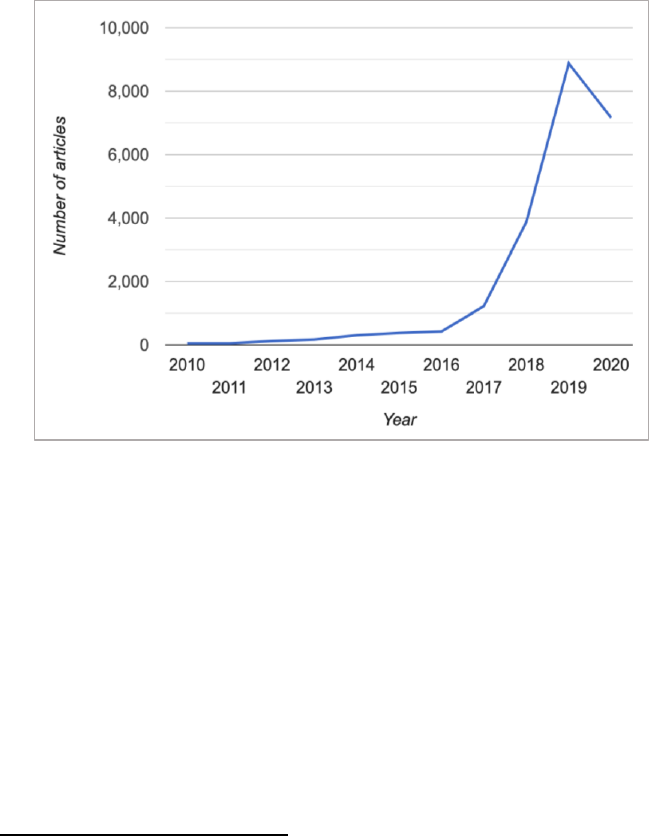
2022]
SHORT
23
Figure 1. Sample Document Corpus
We chose to explore news coverage of big tech regulation, rather
than other communication mediums for two reasons. First, news
coverage provides clues to what elites are thinking and doing, especially
when prominent actors (executives, politicians, financiers, for
example) turn their attention to the subjects reported.
100
Because large
technology corporations are some of the most influential actors in our
public sphere, their actions are covered regularly by journalists. In
addition, journalists are well-read, knowledgeable in diverse social
fields, and writing for public audiences.
101
Often using quotes from
institutional actors, journalists embody within their accounts the
language, arguments, and narratives these speakers use to frame,
report and interpret the topic at hand.
102
Second, news coverage of big tech regulation is important
because it influences the views of the reading public.
103
As sociologist
100
Susanne Janssen, Giselinde Kuipers & Marc Verboord, Culture Globalization and Arts
Journalism: The International Orientation of Arts and Culture Coverage in Dutch,
French, German, and U.S. Newspapers, 1955 to 2005, 73 AM. SOCIO. REV. 719 (2008);
Harvey Molotch & Marilyn Lester, News as Purposive Behavior: On the Strategic use of
Routine Events, Accidents, and Scandals, 39 AM. SOCIO. REV. 101 (1974); Stephen D.
Reese, Setting the Media’s Agenda: A Power Balance Perspective, 14 ANNALS INT’L
COMMC’N ASS’N 309 (1991).
101
Paul DiMaggio, Manish Nag & David Blei, Exploiting Affinities Between Topic Modeling
and the Sociological Perspective on Culture: Application to Newspaper Coverage of U.S.
Government Arts Funding, 41 POETICS 570, 573 (2013).
102
Id. at 593.
103
Id. at 573.

24
THE OHIO STATE TECHNOLOGY LAW JOURNAL
[Vol. 19.1
Paul DiMaggio has suggested, news coverage does this in several ways.
It calls readers’ attention to existing interpretations of events and
reinforces those interpretations. It also develops new interpretations
and places them within the broader political, cultural, and social
contexts that people use to interpret such information. In doing so, the
nature of news coverage influences these interpretations by telling and
retelling news events in a selected and directed fashion.
104
Put another
way, news coverage of big tech regulation both reflects and represents
one avenue of dissemination and influence in the formation of public
opinion. For example, if press coverage mentions big tech regulation
topics in association with positive benefits of the companies, these
corporations are likely to enjoy the support of a trusting and benevolent
public. On the other hand, if news coverage uses topics with negative
connotation, public sentiment towards these companies might take a
different path. This may not be directly causal, but the associations are
strong.
105
Ultimately, given the near-instantaneous global spread of
news in the digital age, reported events surrounding big tech regulation
can shape both public opinion and the direction of public policy. Thus,
we explore the news coverage of big tech regulation because news
content holds the unique place of both reporting events and informing
public opinion, which in turn shapes subsequent events.
After selecting the corpus of texts, we had to determine the
number of topics to be identified by the algorithm, optimizing for
predictive capacity and semantic coherence.
106
If the topic model is
asked to identify too few topics, those produced will be so general and
contain such disparate clusters of words that it would be difficult to
make sense of the content or discern any particular frame from the
data. On the other hand, if the algorithm is asked to identify too many
topics, interesting trends might be split up across topics and obscure
their associations and coherence. By identifying an appropriate
number of topics, we can ensure that the algorithm generated topics
that contained words that were clustered in a semantically coherent
fashion without excluding words that logically belonged in that cluster.
To determine the appropriate number of topics for our corpus
of data, we trained multiple models with up to 100 topics in increments
104
Id.
105
Id.; SHANTO IYENGAR, IS ANYONE RESPONSIBLE? HOW TELEVISION FRAMES POLITICAL
ISSUES (Univ. of Chi. Press) (2001); PRICE V & TEWSKBURY D, “NEWS VALUES AND PUBLIC
OPINION: A THEORETICAL ACCOUNT OF MEDIA PRIMING AND FRAMING” IN BARNETT, G AND
BOSTER F. J. (EDS) PROGRESS IN COMMUNICATION SCIENCE, ABLES, GREENWICH CT. (1997).
106
The topic modeling procedures that follow closely match those set forth in see
Hemmatian et al., supra note 88; Babak Hemmatian, Taking the High Road: A Big Data
Investigation of Natural Discourse in the Emerging U.S. Consensus about Marijuana
Legalization (Feb. 12, 2022) (Ph.D. thesis, Brown University) (on file with
ResearchGate.net) (further procedural details can be found in these earlier publications).

2022]
SHORT
25
of 25. For each of these models, we then looked at quantitative
assessments that measured how certain a particular model was in its
predictions of sample testing data,
107
as well as the co-occurrence of
words that belong to the same topic.
108
We also subjected the results of
the alternative models to a qualitative assessment in which we
manually inspected the top 40 words most strongly associated with
each of the topics to ensure that the topics align logically and
experientially with real-world topics.
109
These trial runs suggested that
asking the algorithm to identify 50 topics would yield the most
coherent, analytically useful results.
110
107
As a first quantitative measure, we looked at per-word perplexity for each model. In
machine learning, perplexity is a way of measuring how well a model predicts a held-out
sample, often used for model comparison. Per-word perplexity, in particular, reflects how
uncertain the model is on average when predicting each word in a document, given the
other words in a document. We use the rate at which this uncertainty increases with
incremental additions to the number of topics as a second, more sophisticated measure of
model quality. Weizhong Zhao, James J. Chen, Roger Perkins, Zhichao Liu, Weigong Ge,
Yijun Ding, & Wen Zou, A Heuristic Approach to Determine an Appropriate Number of
Topics in Topic Modeling, 16 BMC BIOINFORMATICS, Sept. 25, 2015(This measure has been
shown to outperform simple per-word simplicity in evaluating model coherence).
108
As a second quantitative test of fit, we calculated the UMass coherence values for all
models. UMass coherence measures how often the words that comprise a topic actually
appear together in documents. David Mimno, Hanna M. Wallach, Edmund Talley, Miriam
Leenders, & Andrew McCallum, Optimizing Semantic Coherence in Topic Models,
PROCEEDINGS OF THE CONF. ON EMPIRICAL METHODS IN NAT. LANGUAGE PROCESSING 262–
72 (2011) (this is an intuitive measure of topic coherence, because if two words in a topic
really belong together you would expect them to show up together frequently in
documents. Like perplexity, the UMass coherence measures showed a preference for fewer
topics (see Appendix 1 for values). Both measures, per-word perplexity and UMass
coherence, inclined us to choose a model with fewer topics).
109
While perplexity and UMass measures are both suitable approximations of the
interpretability of topics, they sometimes do not align with humans’ intuitive semantic
understanding or actually circulating cultural frames (memes). While quantitative
measures of fit are crucial to optimizing the model, the gold standard of coherence is
aligning the topics identified by the model with human understandings of the subject
matter. Jonathan Chang, Jordan Boyd-Graber, Sean Gerrish, Chong Wang, & David M.
Blei, Reading Tea Leaves: How Humans Interpret Topic Models, 22 ADVANCES IN NEURAL
INFO. PROCESSING SYS. 288 (2009); To choose the top words for qualitative analysis, an
intuitive formula was used that accounts for the baseline popularity of particular words
(see the source in Footnote 72). Keith Stevens, Philip Kegelmeyer, David Andrzejewski &
David Buttler, Exploring Topic Coherence Over Many Models and Many Topics, PROC. OF
THE 2012 JOINT CONF. ON EMPIRICAL METHODS IN NAT. LANGUAGE PROCESSING AND
COMPUTATIONAL NAT. LANGUAGE LEARNING 952, 952–61 (2012).
110
As a robustness check to ensure that the stability of the 50-topic model was not the
idiosyncratic result of the exact number of topics used, we examined models using 45 and
55 topics. These models yielded similar quantitative and qualitative measures of stability
whose similar quantitative and qualitative measures ensured the stability of the 50-topic
model and not the result of the exact number of topics used. A complete list of these topics
and the top words associated with them are available in a digital repository: noah14noah,
Tech_Regulation_Topic_Modeling, GITHUB.COM,
https://github.com/noah14noah/Tech_Regulation_Topic_Modeling.git
[https://perma.cc/A8SF-3LXT] (last visited Nov. 19, 2022).

26
THE OHIO STATE TECHNOLOGY LAW JOURNAL
[Vol. 19.1
Having selected our data set and the optimal number of topics,
we then identified and labeled the most relevant and coherent topics
that the algorithm produced.
111
We identified a subset of top topics by
calculating the average contribution a topic made to the overall corpus
in each month and over the life of the sample (see Appendix 2 for
explanation of calculations). We designated a specific topic as top topic
if it met one of two criteria: (1) it was a major contributor to the
discourse overall based on the algorithmic model (> 3% average
monthly contribution);
112
or (2) it demonstrated significant temporal
trends based on the coefficients of a polynomial regression model. After
this initial filtering step, we examined the five most representative
sample articles
113
from each of the top topics to obtain more linguistic
and substantive content that would enable us to identify the theme and
label for each topic. Table 1 presents our top topics and the set of high-
probability words associated with each (referred to as “top words”).
114
111
Even within the optimized, 50-topic parameter, not all topics were equally relevant or
coherent. For instance, we determined that certain topics such CEO Interviews (comprised
of representative articles reproducing interviews with tech company CEOs on a multitude
of topics, with very little discussion of regulation) and Earnings Reports (reproducing
companies’ quarterly earnings reports) were not coherent or relevant in light of the
theoretical concerns of the present study.
112
The 3% threshold was selected because it indicates a statistical justification from the
expected contribution of each topic. In a 50-topic model, if topics are uniformly
distributed, each would account for 2% of the content of the corpus. Any topic with 3% or
more has at least 50% higher contribution than expected from pure randomness.
113
An article’s representativeness of a specific topic was operationalized as the percentage
of words in the article for which that topic was the most probable topic according to the
LDA model. You can find all of the figures and representative articles in this project’s
Github repository; noah14noah, supra note 110.
114
High-probability words are words that occur with the highest probability among a
topic’s complete list of associated and that were not found in similar lists for other top
topics. Some words (e.g. regulation, tech) have high probability under all topics and thus
do not capture the topic’s focus. These words have been removed from Table 1 to more
clearly represent the topic’s focus. The words including ‘_’ represent common singular
phrases that were transformed into a single word for more accurate analysis during
preprocessing, using a popular text analysis package; Phrase (collection) detection,
GENSIM (May 6, 2022), https://radimrehurek.com/gensim/models/phrases.html.

2022]
SHORT
27
Table 1. Top Topics and Top Words
Top Topics and Top Words
Topic Title
Top Five Most Associated Words (in
Descending Order)
Framing
know, say, get, right, well
Calls for Regulation
company, government, technology, new, need
Content Compensation
news, content, platform, advertising, publisher
Risks to Market
market, economy, economic, bank, risk
International
tiktok, canada, government, new zealand,
minister
Emerging Technologies
company, tech, silicon_valley, startup, founder
Tech Antitrust
market, competition, antitrust, platform,
consumer
Telecom Antitrust
internet, fcc, net_neutraility, service, telecom
Trump Administration
trump, president, house, white_house,
administration
Critiques of Capitalism
public, power, social, free, right
Competing with Big
Tech
business, market, new, product, client
Stock Market
stock, investor, percent, price, share
Crypto and Payments
financial, banking, payment, fintech, credit
Trump Censorship
content, platform, medium, speech,
section_230
EU Regulation
european_union, europe, country, commission,
rule
Earnings Reports
growth, revenue, business, quarter, million
US Privacy Regulation
privacy, information, consumer, personal_data,
law
Calls for Accountability
facebook,, platform, cambridge_analytica,
privacy, election
Cloud Computing
amazon, cloud_computing, software, aws,
contract
Campaign Criticisms
candidate, biden, campaign, democratic, voter
Facial Recognition
facial_recognition, technology, surveillance,
law, enforcement
AI
articifical_intelligence, computer, machine,
algorithm, learning
Support for Regulation
federal, law, ftc, department, agency
COVID
coronavirus, pandemic, health, case, virus
Interviews
think, get, know, really, right
China Policy
china, trade, india, world, hong_kong

28
THE OHIO STATE TECHNOLOGY LAW JOURNAL
[Vol. 19.1
EU Data Privacy Law
law, case, legal, regulation, enforcement
Heath Care
health, system, research, healthcare, patient
Monitoring COVID
monitor, international, business, covid-19,
source
Brexit
prime_minister, quest, Brexit, deal, can
Financial Earnings
Bartiromo, get, right, think, morning
Reporting
police, say, report, people, man
Coverage of Antitrust
Hearings
google, amazon, search, apple, antitrust
Framing
one, year, say, make, get
Reporting
post, report, article, 2020, 2019
Telenor Scandal
telenor, share, year, value, average
From this analysis of topic constructions, representative
articles, and high probability words, we were able to narrow our results
to 9 identifiably coherent trends that contributed to the discourse
either through significant changes over time or overall contribution to
the discussion in the corpus: Calls for Regulation, Tech Antitrust, EU
Data Privacy Law, US Privacy Regulation, Emerging Technologies,
Support for Regulation, Competing with Big Tech, Stock Market, and
Critiques of Capitalism. We also identified four topics associated with
incidents that precipitated isolated bursts of discussion about tech
regulation: Content Compensation, Trump Censorship, Calls for
Accountability, and Campaign Criticisms. We report and analyze these
topics in Part III below.
C. The Limitations of Algorithmic Topic Modeling
The quality of an algorithm is largely a function of its inputs (in
this case, the corpus of news articles used). As seen in Figure 1, most of
the articles appeared in more recent years. Therefore, the model was
biased in favor of the statistical properties of discourse in those years.
Relatedly, the estimates of topic prominence are noisier for early years
in ways that are not reflected in our regression modeling. Temporal
patterns associated with those years should therefore be considered
with greater caution. This may be a consequence of the keyword
query— “big tech” and “regulation” and its lexemes—we used to
generate our data from the LexisNexis database, which was narrow in
its scope. As the use of “Big Tech” has been paired with the growth of
prominent technology companies, the news coverage we collected
pertains to regulation of these larger companies, rather than these
same companies in their infancy or their smaller counterparts today.
That said, discussions around regulation of technology companies
associated with “big tech” increased as these companies have acquired

2022]
SHORT
29
greater control of digital infrastructures and market power.
Consequently, the content analysis of this discussion, as it emerged in
the 20-teens, is revealing.
With respect to the topic modeling algorithm, the distributions
representative of top topics partly reflects our parameter choices, such
as the number of topics. Although we based our choice of parameters
on careful analysis of the corpus, better values might exist. We also note
that, due to our choice about what to include in the data set and the
nature of discourse in the news articles that comprise our sample, our
analysis may have excluded some topics relevant to the public
discussion about regulating big technology companies. We therefore
recommend that future research repeat this analysis with a different set
of search terms.
More generally, the inherent shortcomings of topic modeling
may have affected our results. The algorithm treats the text of articles
in our corpus as a “bag-of-words,” and it identifies statistical
correlations among those words. The model cannot assess important
aspects of language, including meanings associated with punctuation,
grammar, and sequential dependencies between words. Accordingly,
we urge readers to treat the empirical and epistemological claims we
make about the top topics with a prudent degree of caution.
115
IV. Public Discourse on Big Tech Regulation: Findings
The most significant result of our topic modeling study was the
discovery of a dog that didn’t bark. Despite assessing tens of thousands
of pages of news reports concerning the regulation of large technology
corporations, our model did not identify any topics associated with the
techno-libertarian ideology. That is, the topic modeling algorithm
failed to find clusters of words suggesting that a significant theme in
discussions of the regulation of big tech was a techno-libertarian one.
As prevalent as this narrative is in big tech’s discourse about itself and
in its lobbying strategy, it does not appear to have much traction in the
media discourse about big tech and regulation.
116
To the contrary, the
most prevalent topics identified in our modeling study demonstrate
that there has been significant discussion in the media about regulating
big tech.
117
That is, topics that made up the largest percentage of the
corpus of materials we examined related to calls for increased
regulation of technology companies, not techno-libertarian defenses of
their autonomy. Indeed, our results suggest that there have been
115
Blei et al., supra note 88.
116
Because our model did not identify topics associated with the tech-utopian libertarian
narrative, we are unable to make direct comparisons between this discourse and the topics
we analyze. Future research should be designed to enable such direct comparisons.
117
See infra

30
THE OHIO STATE TECHNOLOGY LAW JOURNAL
[Vol. 19.1
substantial and growing calls for regulation since 2010. These trends
are reflected in the subject matter of several of the top topics that our
study identified.
For example, the topic that saw the greatest increase over the
period of our study was one that we labeled “Calls for Regulation” (see
Figure 2).
118
Representative articles comprising this topic include
reporting about legislators and others calling for more regulation of
large platform companies.
119
Such calls comprise less than 2% of the
corpus in 2010 but rise to encompass nearly 15% of the corpus by its
peak in 2019. This means that during this time, coverage calling for
more tech company regulation increased seven-fold.
118
The analysis of temporal trends using locally smoothed polynomial regressions follows
the guidelines set forth in see Hemmatian et al., supra note 88; itself adapted from Uriel
Cohen Priva & Joseph L. Austerweil, Analyzing the history of Cognition using topic
models, 135 COGNITION 4, 4-9 (2015). The local smoothing allows us to see the impact of
punctual events on discourse, while the polynomial constraints help minimize the effect of
noise. The gray areas around the resulting regression lines show the 95% confidence
intervals for a topic’s estimated contribution to discourse, calculated at the level of
monthly proportions rather than individual documents.
119
Sam Clark, More Digital Regulation on the Way, Study Finds, HOGAN LOVELLS (Nov. 4,
2019), https://www.hoganlovells.com/en/publications/more-digital-regulation-on-the-
way-study-finds [https://perma.cc/47GN-E28T]; Press Release, Targeted News Serv., Sen.
Cruz: Latest Twitter Bias Underscores Need for Big Tech Transparency (Aug. 16, 2019),
https://www.cruz.senate.gov/newsroom/press-releases/sen-cruz-latest-twitter-bias-
underscores-need-for-big-tech-transparency [https://perma.cc/6MVM-MJBL]; Macer
Hall, “New Code” to Crack Down on Net Giants, DAILY EXPRESS (Feb. 18, 2019),
https://www.pressreader.com/uk/daily-express/20190218/page/9/textview
[https://perma.cc/AUX5-MX87]; Adam Sherwin, Wright Tells Zuckerberg: Make
Facebook Safe, I-INDEP. PRINT LTD., Feb. 21, 2019, at 21; David Manners, Big Tech Needs
Regulation Says House of Lords, ELECS. WKLY. (Mar. 11, 2019),
https://www.electronicsweekly.com/news/business/big-tech-needs-regulation-says-hol-
2019-03 [https://perma.cc/U7CS-6EQ4].
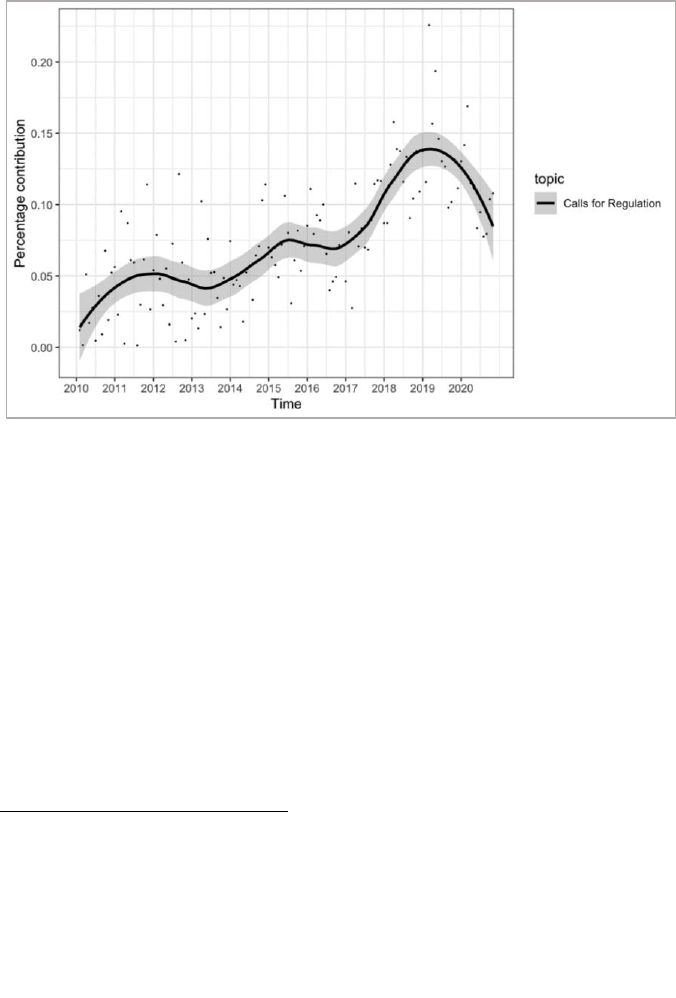
2022]
SHORT
31
Figure 2. Topic: Calls for Regulation
The model also demonstrates growing calls for regulation
specifically in the areas of antitrust and privacy. The “Tech Antitrust”
topic (see Figure 3) shows a significant positive trend in calls for
antitrust regulation, rising from almost no discussion in 2010 to over
3.5% in 2020. The most representative articles that comprise this topic
include articles raising concerns about the monopoly power of large
platform companies and discussing plans for stricter enforcement of
antitrust laws against them.
120
120
Lauren Almeida, Is Amazon Good for the Market or the Consumer?, INVS. CHRON., July
31, 2020, at 61 (discussing Lina Khan, Amazon’s Antitrust Paradox, 126 YALE L.J. 710
(2017)); Greg Ip, UK Panel Plans Code of Conduct for Tech Giants, THE AUSTRALIAN, Mar.
15, 2019, at 27 (discussing how codes of conduct can be used to combat monopoly power);
Amanda Lotz, Amazon, Google, and Facebook Warrant Antitrust Scrutiny for Many
Reasons—Not Just Because They’re Large, THE CONVERSATION (June 24, 2019, 8:47 AM),
https://theconversation.com/amazon-google-and-facebook-warrant-antitrust-scrutiny-
for-many-reasons-not-just-because-theyre-large-118370 [https://perma.cc/GJ69-XJPG]
(describing the growing chorus of politicians, antitrust scholars, and consumer watchdogs
calling for stricter antitrust treatment of big tech companies); David Hatch, Europe to Rein
in Big Tech with U.K. Powers, THE DEAL (Apr. 24, 2020) (discussing antitrust concerns of
the European Commissioner for Competition); Noah Smith, Antitrust Scrutiny Should be
Broader, BLOOMBERG (July 31, 2020).
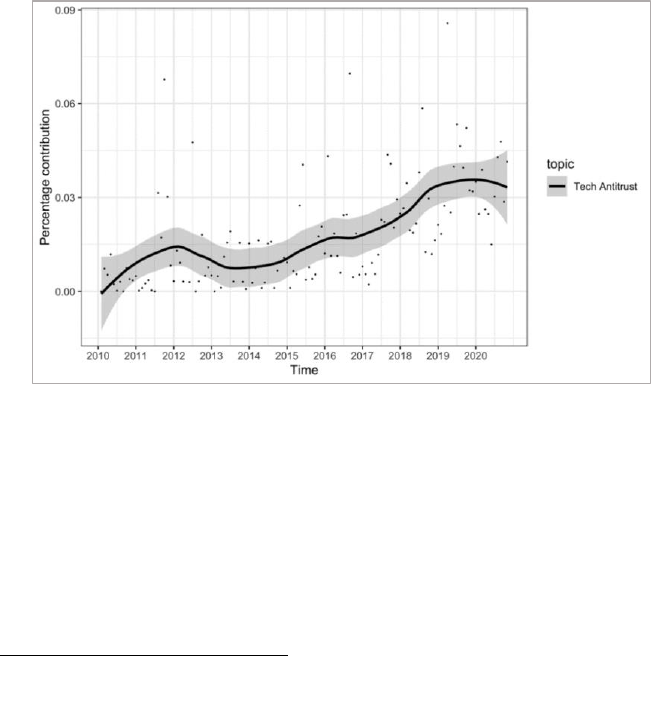
32
THE OHIO STATE TECHNOLOGY LAW JOURNAL
[Vol. 19.1
Figure 3. Topic: Tech Antitrust
Other top topics focused on the need for specific forms of tech
regulation. The topic “EU Data Privacy Law” (see Figure 4) included
articles reporting about privacy regulation on both sides of the
Atlantic.
121
This topic peaks at over 5% of corpus contribution just
before 2014, in the lead-up to the European Commission’s adoption of
the landmark General Data Protection Regulation (“GDPR”). Coverage
of privacy regulation in the United States lags coverage of privacy
regulation in the EU in terms of percent contribution, but the topic “US
Privacy Regulation”
122
(see Figure 5) trends upward significantly
121
Press Release, Mishcon de Reyes, Is “Big Tech” Facing Multiple Showdowns with the
EDPB [European Data Protection Board]?, Impact Fin. News (Aug. 26, 2020); Press
Release, UK Government, Data Protection Bill [Lords] Next Share this Debate 09 May
2018 Volume 640 (May 14, 2018); Press Release, N.Y. State Bar Ass’n, America’s Tech
Giants: It’s Back to the Drawing Board on European Data(Sept. 10, 2020); James R.
Carroll, Brian W. Duwe, David C. Eisman, Patrick Fitzgerald, Todd E. Freed, Marc S.
Gerber, Richard J. Grossman, Michael E. Leiter, Stuart D. Levi, Amy S. Park, William
Ridgway, Jason D. Russell, Ivan A. Schlager, David E. Schwartz, Jennifer L. Spaziano,
Ingrid Vandenborre, Donald L. Vieira, Helena J. Derbyshire, Jessica N. Choen, Peter
Luneau, James S. Talbot & Eve-Christie Vermynck, Skadden, European Union: The GDPR
At The One Year Mark: A Work In Progress, MONDAQ (July 11, 2019),
https://www.mondaq.com/uk/security/824126/the-gdpr-at-the-one-year-mark-a-work-
in-progress [https://perma.cc/ZR42-ZJVY].
122
Representative articles and media coverage of press releases include: Senators Markey
and Hawley Introduce Bipartisan Legislation to Update Children’s Online Privacy Rules,
TARGETED NEWS SERV. (Mar. 12, 2019); Sen. Markey: Senate Democrats Unveil Strong
Online Privacy Rights, TARGETED NEWS SERV. (Nov. 26, 2019); Shiva Stella, 34 Civil
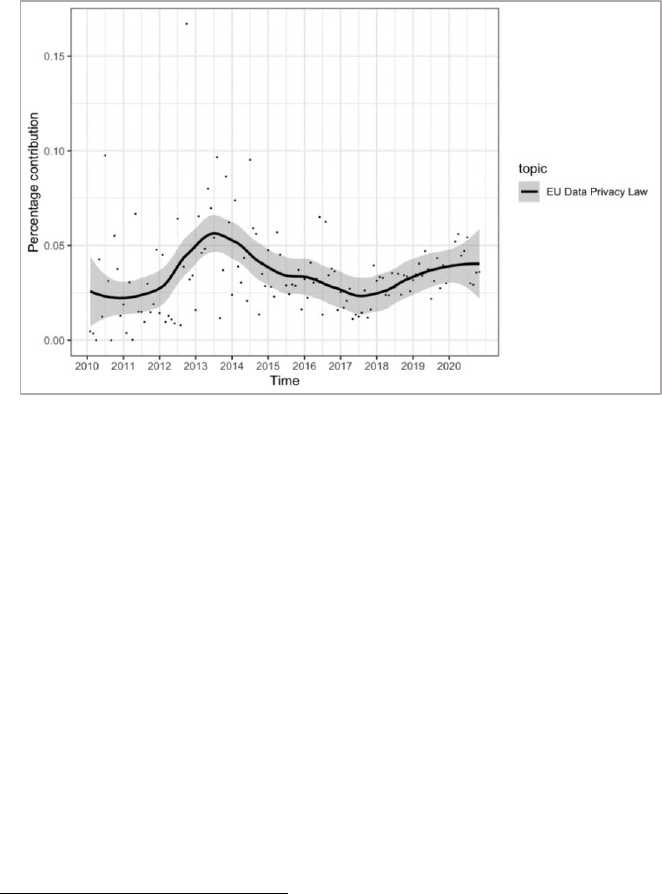
2022]
SHORT
33
starting in mid-2017, peaking at 4% in 2019, the year Senators Edward
J. Markey (D-Mass.) and Josh Hawley (R-Mo.) introduced bipartisan
legislation to update children’s online privacy rules.
Figure 4. Topic: EU Data Privacy Law
Rights, Consumer, and Privacy Organizations Unite to Release Principles for Privacy
Legislation, Pub. Knowledge (Nov. 13, 2018), https://publicknowledge.org/34-civil-rights-
consumer-and-privacy-organizations-unite-to-release-principles-for-privacy-legislation
[https://perma.cc/7V3P-4WFB].
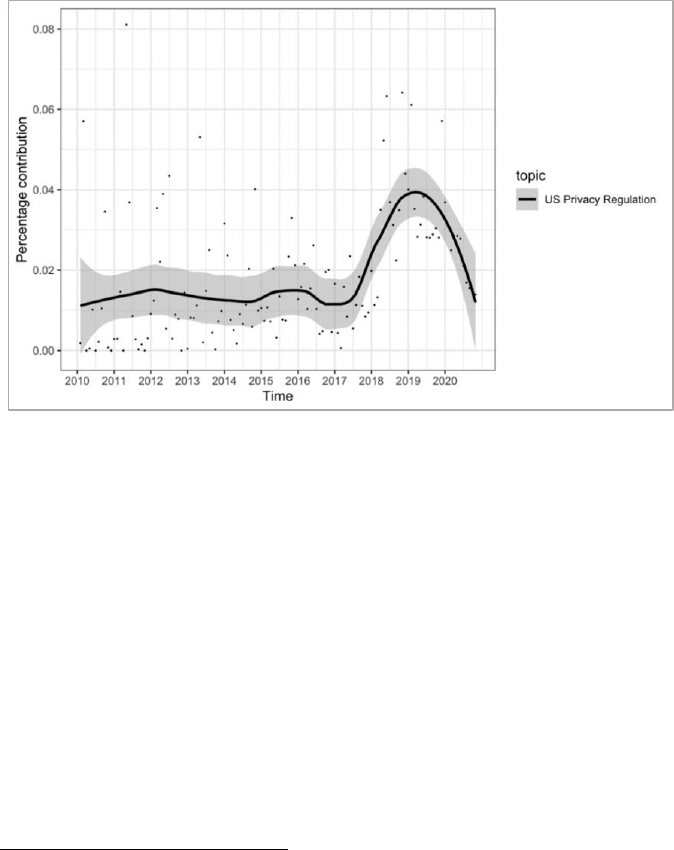
34
THE OHIO STATE TECHNOLOGY LAW JOURNAL
[Vol. 19.1
Figure 5. Topic: U.S. Privacy Regulation
The “Emerging Technologies” (see Figure 6) topic, which
includes articles on the regulation of emerging technologies such as
self-driving cars, also accounted for a significantly larger-than-average
contribution to the corpus than a uniform model’s predicted
contribution during the years 2010 to 2017 (approximately 3.2%
contribution), and then declined after 2017.
123
The most representative
articles comprising this topic reflect a range of views on the regulation
of emerging technologies. While there was some evidence of techno-
libertarian ideas in an interview with tech entrepreneur Marc
Andreessen, who commented that some emerging tech fields (e.g.,
biotech, stem cell research, 3-D printing, drones) face “huge regulatory
hurdles [,]”
124
other articles reflected an openness to regulation in this
area. Another article quotes a Medium post by Dan Ammann, CEO of
self-driving car company Cruise, saying: “When you’re working on the
large-scale deployment of mission critical safety systems, the mindset
123
If the model was uniform, that is, if each topic contributed the same amount to the
corpus, 50 topics would predict a predicted 2% contribution from each topic.
124
Nick Bilton, Forecasting the Next Big Moves in Tech, N.Y. TIMES, May 19, 2014, at B8;
see also Rob Thubron, Uber Partners with University of Arizona as It Looks to Advance
Its Self-driving Car Project, TECHSPOT (Aug. 26, 2015, 1:30 PM),
https://www.techspot.com/news/61898-uber-partners-university-arizona-looks-advance-
self-driving.html [https://perma.cc/K9HQ-JG8J] (reporting that Arizona Governor, Doug
Ducey, “told state regulators they couldn’t enforce rules that require Uber drivers to have
commercial insurances and licenses, saying the policy was hampering job creation and
stifling innovation”).

2022]
SHORT
35
of ‘move fast and break things’ certainly doesn’t cut it.”
125
The article
goes on to discuss cooperation between tech companies and regulators
to develop benchmarks for assessing the safety of self-driving cars.
126
Other articles in this topic discuss the myriad challenges facing
developers of emerging technologies. Regulation is among the
challenges discussed, but the articles tend to highlight fierce market
competition as a barrier to the success of emerging technologies. This
is reflected in the topic’s top words (company, tech, valley, silicon
valley, say, uber, startup, founder, ceo), which all reference key features
of tech company competitors.
127
Figure 6. Topic: Emerging Technologies
In addition to coverage of regulation in specific subject matter
areas, the “Bipartisan Support for Regulation” topic (see Figure 7)
captures sustained coverage of partnerships between state and federal
125
Joseph White, GM Cruise to Delay Commercial Launch of Self-driving Cars to Beyond
2019, REUTERS (July 24, 2019, 5:56 AM), https://www.reuters.com/article/us-gm-
cruise/gm-cruise-to-delay-commercial-launch-of-self-driving-cars-to-beyond-2019-
idUSKCN1UJ1NA [https://perma.cc/69YK-Y82F].
126
Id.
127
Mark Matousek, Apple, Waymo, and Even Amazon Will Have a Huge Advantage
Against Tesla in the Race to Launch Self-driving Taxis, One Wall Street Analyst Says
(TSLA), BUS. INSIDER (Oct. 9, 2018, 6:50 PM), https://www.businessinsider.com/tesla-
may-lose-to-apple-amazon-and-waymo-in-self-driving-taxis-2018-10
[https://perma.cc/TR2Y-Y93B]; Apple “Rethinking” Self-driving Car Plans, SCI. WORLD
REP. (Sept. 12, 2016, 6:09 AM),
http://www.scienceworldreport.com/articles/47314/20160912/apple-rethinking-self-
driving-car-plans.htm [https://perma.cc/HC3G-DWX4].
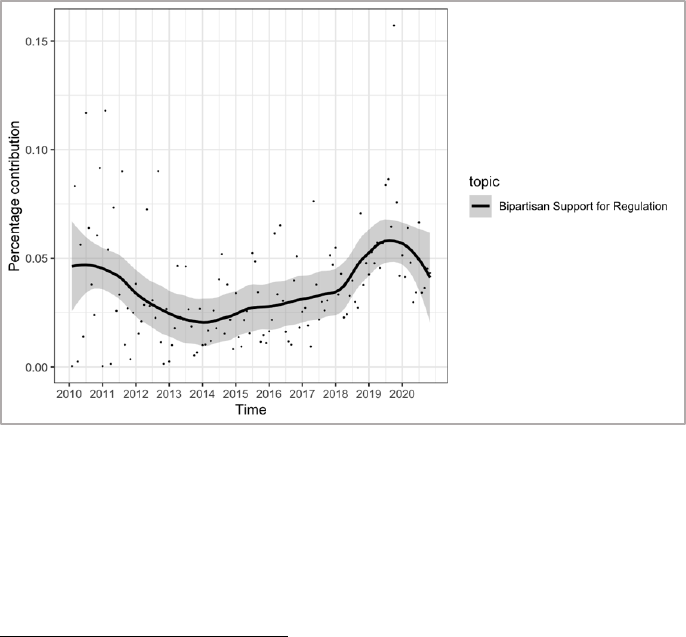
36
THE OHIO STATE TECHNOLOGY LAW JOURNAL
[Vol. 19.1
regulators across party lines to regulate big tech companies. For
example, representative articles comprising this topic report on
cooperation between federal and state regulators of different party
affiliations to investigate antitrust violations by large platform
companies such as Facebook and Google.
128
This topic was a high
contributor to the corpus throughout the selected years, with relative
peaks around 2010 and 2019.
Figure 7. Topic: Bipartisan Support for Regulation
The model also reveals widespread discussion of big tech
regulation in the context of competition with incumbent, non-platform
competitors such as banks. While no significant change in contribution
to the corpus was observed in the “Competing with Big Tech” topic (see
Figure 8), its inclusion is based on its average contribution of
approximately 4.7% of the corpus across all sample years, a 135%
greater contribution than a uniform distribution’s 2% predicted
128
Margaret Harding McGill, NY Attorney General Talks Facebook with DOJ, AXIOS (Oct.
7, 2019), https://www.axios.com/ny-attorney-general-doj-facebook-letitia-james-
518a9be4-91ad-4c96-a157-aa0d0007309b.html [https://perma.cc/5NZV-AV9P]; Steve
Lohr, Regulating Big Tech is a Bipartisan Issue, BOS. GLOBE, Sept. 7, 2019, at A9; Casey
Egan, Report: Majority of State Attorneys General Prepping Antitrust Probe into Google,
SNL KAGAN MEDIA & COMMC’NS REP. (Sept. 4, 2019); 47 Attorneys General Back Antitrust
Probe into Facebook, A.P. NEWS (Oct. 22, 2019), https://apnews.com/article/technology-
business-us-news-media-district-of-columbia-88df3224fe794cf099d6a5b212b7ddf4
[https://perma.cc/9YXL-VPJN]; US Justice Department Teams Up with States on Probe
of Big Tech Firms, REUTERS (Aug. 20, 2019, 8:49 AM),
https://www.reuters.com/article/us-tech-antitrust-delrahim/u-s-justice-department-
teams-up-with-states-on-probe-of-big-tech-firms-idUSKCN1VA1OR
[https://perma.cc/D4MX-RX6K ].

2022]
SHORT
37
contribution. Representative articles include editorial content alerting
incumbent firms to the growing competitive threat posed by big tech
platforms
129
and advising incumbent firms how to compete with their
big tech rivals.
130
Regulation comes into this discussion in three ways
that have little to do with techno-libertarian themes: (1) as an
impediment hindering incumbent banks’ ability to compete with
fintech rivals;
131
(2) as a potential “accelerator for banks”
132
in their
efforts to meet competition from platform companies; and (3) as a
challenge that technology can help banks solve (i.e., by helping them
manage their regulatory obligations).
133
129
See, e.g., Suprana Biwas, Brant Carson, Violet Chung, Shwaitang Singh & Renny
Thomas, AI-Bank of the Future: Can Banks Meet the AI Challenge?, MCKINSEY & CO.
(Sept. 19, 2020), https://www.mckinsey.com/industries/financial-services/our-
insights/ai-bank-of-the-future-can-banks-meet-the-ai-challenge [https://perma.cc/J8JM-
P9LB] (reporting that “big-tech companies are looking to enter financial services as the
next adjacency”); CXOtoday News Desk, Digital Transformation In Financial Sector To
Get Bigger, CXOTODAY.COM (Jan. 30, 2019), https://www.cxotoday.com/news-
analysis/digital-transformation-in-financial-sector-to-get-bigger [https://perma.cc/95BG-
Q3RH] (discussing banks’ need to innovate to compete with FinTechs).
130
Wealth Managers Need to ‘Democratize’ Their Services to Thrive in the Hyper-
Personalized, Digital Banking Era, Warns Avaloq, AVALOQ (Sept. 17, 2020),
https://www.avaloq.com/en/-/wealth-managers-need-to-democratize-their-services
[https://perma.cc/Y42D-J8YU]; Chira Barua, Balazs Gati, András Havas, Tara Lajumoke,
Miklos Radnai & Zubin Taraporevala, How Banks Can Use Ecosystems to Win in the SME
Market, MCKINSEY & CO. (June 10, 2019),
https://www.mckinsey.com/industries/financial-services/our-insights/how-banks-can-
use-ecosystems-to-win-in-the-sme-market [https://perma.cc/5QQW-A32B] (discussing
how banks can use existing technology platforms (ecosystems) to attract new customers).
131
CXOtoday News Desk, supra note 129.
132
Id. (“[R]egulation, such as GDPR is often viewed as a hindrance to digital
transformation. But, in many cases it’s acted as an accelerator for banks and the trends will
continue for the coming year.”).
133
Biwas et al., supra note 129 (describing how AI can help banks with their regulatory
reporting obligations); Obi Omile, Why Niche SaaS Scales So Well, VENTUREBEAT (Sep. 12,
2020, 5:07 PM), https://venturebeat.com/2020/09/12/why-niche-saas-scales-so-well
[https://perma.cc/9F7V-TAMW] (marketing a product to help companies “quickly scale
and operate more efficiently” to compete more effectively with big tech platforms).
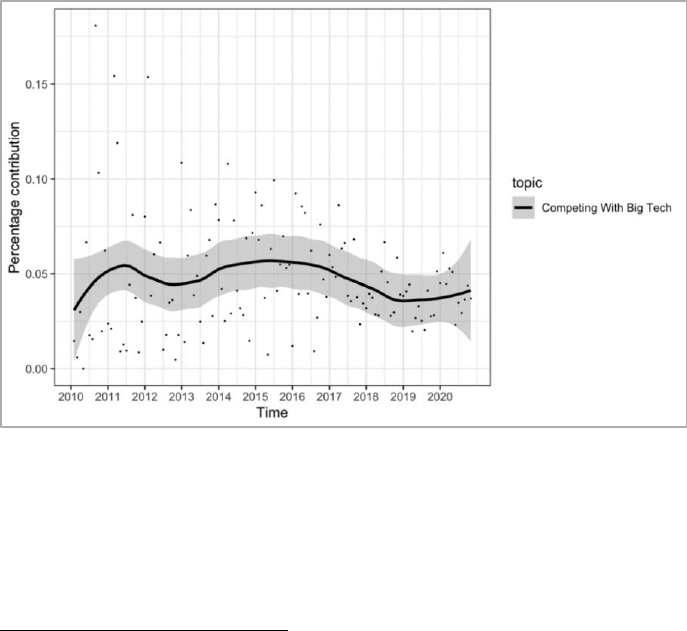
38
THE OHIO STATE TECHNOLOGY LAW JOURNAL
[Vol. 19.1
Figure 8. Topic: Competing with Big Tech
Beyond explicit discussions of regulation, the model reveals
interesting trends in two broader themes relating to technology and the
economy. First, the topic titled “Stock Market” (see Figure 9) comprises
articles reporting on the performance of tech stocks and their outsize
influence on the stock market.
134
This topic contributes 15% of the
134
Angela Moon, Tech Earnings Take the Focus Next Week, GRAND FORKS HERALD, July
12, 2014, at C3 (reporting that the tech sector is out-performing the rest of the market in
anticipation of next quarterly earnings report); Paul R. La Monica, The Stock Market Now
Has Two $1 Trillion Companies: Amazon and Microsoft, CNN (July 11, 2019, 5:47 PM),
https://www.cnn.com/2019/07/11/investing/amazon-microsoft-trillion-dollar-market-
value/index.html [https://perma.cc/M7MN-9QAZ] (“Big Tech stocks have soared this
year, despite concerns about the possibility of more regulation in the United States and
worldwide as well as trade tension between the United States and China. So far, their sales
and earnings growth have remained relatively strong.”); Noel Randwich, Deep Losses
Leave Big Tech With Small Earnings Multiples, REUTERS (Dec. 10, 2018, 6:02 AM),
https://www.reuters.com/article/us-usa-stocks-earnings-faangs/deep-losses-leave-big-
tech-with-small-earnings-multiples-idUSKBN1O91C3 [https://perma.cc/Q9DK-AJRA]
(reporting on the unexpectedly poor performance of big tech stocks in 2018); Paul R. La
Monica, When Apple Has a Bad Day, We All Have a Bad Day, CNN (Mar. 29, 2018, 1:14
PM), https://money.cnn.com/2018/03/29/investing/tech-stocks-apple-amazon-facebook-
google-microsoft/index.html [https://perma.cc/K89C-EZDC] (tying stock market
performance to big tech stock performance and inquiring whether big tech companies have
too much sway over financial markets); Stan Choe & Damina J. Troise, Stocks End Another
Day of Sharp Swings With Meager Gains, ASSOCIATED PRESS (Sept. 11, 2020, 4:14 PM),
https://www.detroitnews.com/story/business/2020/09/11/us-stocks-edge-higher-end-
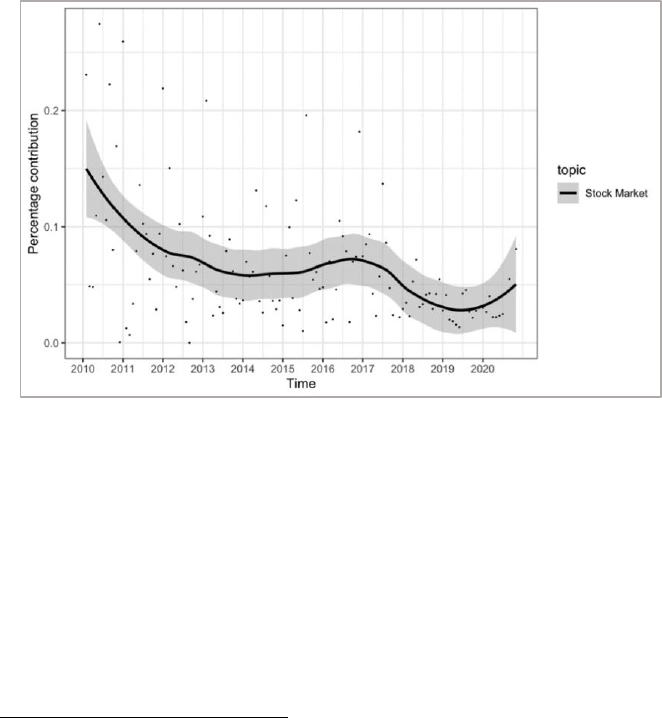
2022]
SHORT
39
corpus at the beginning of the sample period in 2010 but declines
dramatically to under 5% by 2020. Although this still represents a
significantly larger portion of the discourse on big tech (compared to a
uniform distribution model), it appears that discussions of big tech’s
market performance are being crowded out to some degree by the
increasing calls for regulation documented above.
Figure 9. Topic: Stock Market
The second broad topic, titled “Critiques of Capitalism” (see
Figure 10), encompasses articles that present deep critiques of
capitalism
135
and big technology’s role in it. This topic trends upward
from 3% in 2010 to nearly one-tenth of the entire corpus by 2018,
returning to just over 5% by the of the sample years. The most
representative articles include: an interview with Slavoj Zizek on the
rise of populism and other anti-establishment trends,
136
an essay
critiquing prevailing conceptions of privacy as supporting “bourgeois
rocky-week-trading/3467455001/ [https://perma.cc/6PEA-VN4L] (discussing big tech
stocks’ influence on the broader market).
.
135
Gabriel Winant, Is Anti-monopolism Enough?, THE NATION (Jan. 21, 2020, 1:25 PM),
https://www.thenation.com/article/culture/goliath-monopoly-and-democracy-matt-
stoller-review [https://perma.cc/925M-LSG9].
136
N.B., Are Liberals and Populists Just Searching for a New Master?, ECONOMIST (Oct.
8, 2018), https://www.economist.com/open-future/2018/10/08/are-liberals-and-
populists-just-searching-for-a-new-master [https://perma.cc/X5YL-8ET6].

40
THE OHIO STATE TECHNOLOGY LAW JOURNAL
[Vol. 19.1
values of personal autonomy and selfhood”;
137
the need for regulation
of big tech companies to sustain open, democratic societies;
138
and a
proposal to convert private technology companies into publicly owned
utilities.
139
It is interesting to note that most of the words comprising
this topic have a positive valence (political, public, even, power, people,
social, way, free, become, right, world, problem). Indeed, this is the
type of language big tech companies commonly deploy to describe
themselves, their missions, and their value to society. However, based
on a manual review of representative articles, these positive words
appear to be associated not with big technology, but with an idealized
society cleansed of (or protected from) the pathologies of big
technology. Technology companies are portrayed as no different from
any other big business supporting the capitalist order. For example, in
his critical review of Matt Stoller’s book, Goliath: The 100-Year War
Between Monopoly Power and Democracy, historian Gabriel Winant
recalls that John F. Kennedy once griped, “[m]y father always told me
that all businessmen were sons of bitches, but I never believed it until
now!”
140
Winant goes on to suggest that tech businesses are even more
dangerous than the mid-century monopolies to which Kennedy
referred because they “have sunk their roots into large sections of
society. Come after Amazon, and you come after its tens of millions of
users too.”
141
137
Daniël de Zeeuw, Immunity from the Image: The Right to Privacy as an Antidote to
Anonymous Modernity, 17 EPHEMERA 259, 259 (2017).
138
Open Societies Most Likely to Overcome Power, Technological Disruptions, Stanford
Historian Says, STATES NEWS SERV. (Feb. 20, 2018) (“The societies most likely to strike the
right balance between old hierarchies and new social networks will be the open societies,
where appropriate regulation of big tech companies is more likely to be worked out than in
closed societies.”).
139
How the Pandemic Revealed a Morally Bankrupt Culture, ECONMATTERS (May 14,
2020), https://www.econmatters.com/2020/05/how-pandemic-revealed-morally-
bankrupt.html [https://perma.cc/82V8-LD87].
140
Gabriel Winant, Is Anti-monopolism Enough?, THE NATION BLOGS (Jan. 21, 2020),
https://www.thenation.com/article/culture/goliath-monopoly-and-democracy-matt-
stoller-review [https://perma.cc/S4RR-6XU3].
141
Id.

2022]
SHORT
41
Figure 10. Topic: Critiques of Capitalism
In addition to these topic trends, several additional topics
capture bursts of discursive activity surrounding isolated regulatory
events. For instance, representative articles in the “Content
Compensation” topic report on events surrounding the enactment of an
Australian law that authorized local news publishers to charge large
platform companies such as Google and Facebook “fair payment” for
content they post for free. Representative articles comprising the
“Trump Censorship” topic are about a single tweetstorm launched by
then-president Donald Trump in spring of 2020 calling for social media
to be shut down after Twitter added a “fact-check” label to two of his
tweets disparaging mail-in ballots. Similarly, representative articles in
the “Calls for Accountability” topic are clustered in the period
immediately following the Cambridge Analytica scandal, and present
interviews with and quotes from former close associates of Mark
Zuckerberg calling for action to hold Facebook accountable for
decisions precipitating the breach. Finally, representative articles in
the “Campaign Criticisms” topic recount speeches by presidential
candidates in the 2020 democratic primary season criticizing big tech
and proposing more aggressive regulation.
42
THE OHIO STATE TECHNOLOGY LAW JOURNAL
[Vol. 19.1
V. Conclusion
The technology industry has doggedly assembled and deployed
a techno-libertarian ideology proclaiming the social and economic
benefits of—indeed, the social and economic imperative of—an
unfettered internet operating in unregulated markets. What’s more,
this industry has immense power to shape public discourse. Thus, we
might have expected our analysis of news articles to identify topics
reflecting the view that regulating big tech would be a disaster. But it
did not. Instead, the topic model reveals that the public discourse
around big tech and regulation tends to be about how the tech sector
should be regulated and the harms it causes. This counterintuitive
finding opens the field for promising new scholarly inquiries and paves
the way for more meaningful policy debate around the regulation of
technology. We hope that our findings will motivate new research to
dig deeper into the mechanisms driving rhetoric about tech regulation
and its relationship to public policy. Analysis of different corpora—for
instance, spanning a longer time period or encompassing different
sources such as blog posts or social media—could yield useful insights.
In the meantime, our findings should embolden legal and policy
advocates to pursue regulatory initiatives aimed at addressing the
social and economic harms produced by the technology sector knowing
that the techno-libertarian rhetoric likely to be deployed against them
may not have sufficient public traction to win the day.

2022]
SHORT
43
Appendix 1: Choice of Hyperparameters
Following Cohen Priva and Austerweil,
142
α and η were set to .1,
which encourages the model to represent each document as composed
of only a few topics and to assign high probability to only a few words
for a certain topic. The lower bound on per-term topic probability for
inclusion in analyses was set to .01.
Per-word Perplexity: In natural language processing,
perplexity is a measurement of how well a model is at predicting unseen
words. Smaller values are preferable. Note that the per-word perplexity
is lower for evaluation sets with 25 and 50 topics compared with the
relevant training sets. The latter represent held out, randomly selected
documents that add up to 1% of the corpus. This means that the
modeling results do not reflect overfitting to noise within the training
set.
25 Topics
50 Topics
75 Topics
100 Topics
Lower bound on per-word perplexity for training set:
359.71
604.98
1031.05
1777.85
Lower bound on per-word perplexity for evaluation set:
72.42
127.03
164.18
188.90
UMass Coherence This measure was calculated over the
training set. Larger numbers indicate the words in each topic are more
likely co-occur.
25 Topics
50 Topics
75 Topics
100 Topics
-1.030
-1.163
-1.493
-1.398
142
Uriel Cohen Priva & Joseph L. Austerweil, Analyzing the History of Cognition Using
Topic Models, 135 COGNITION 4 (2015), https://doi.org/10.1016/j.cognition.2014.11.006
[https://perma.cc/353R-QH7B].

44
THE OHIO STATE TECHNOLOGY LAW JOURNAL
[Vol. 19.1
Appendix 2: Calculating Topic Contributions
To determine the relative popularity of different topics over
time, we calculated the monthly contribution of topic z
j
(for j ∈ [1, n]) to
the learned model. Following Cohen Priva and Austerweil, this measure
was defined as:
where w
i
is a word in document d; d is a document, represented as an
unordered bag of words in D
m
(the set of documents from month m);
and topic(w
i
) stands for the most likely topic for w
i
given the prior
distribution over topics and the other words present in d. This measure
reflects the percentage of words in a month that are most strongly
associated with a certain topic. In calculating the norm of documents,
only words were counted for which the conditional probability of at
least one topic was more than .01.
